Regula Ysewijn's Blog
October 4, 2015
About my work: Hemelse soepen, the Magic soup book in Dutch // and I'm giving away a copy!
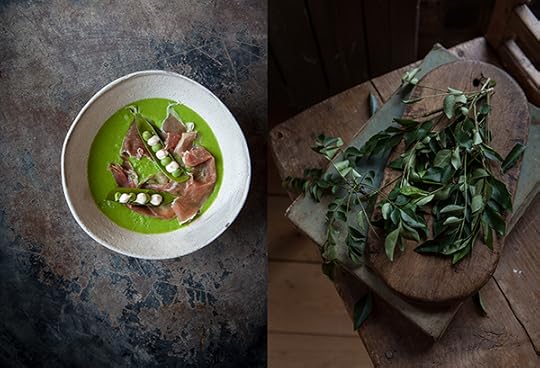 The Dutch version of the book MAGIC SOUP I photographed last year has been published! And... the Belgian publisher Luster has kindly given me a nice parcel to give away to one of you lovely lot!
The Dutch version of the book MAGIC SOUP I photographed last year has been published! And... the Belgian publisher Luster has kindly given me a nice parcel to give away to one of you lovely lot!Just leave a comment below and tell me what your all time favourite soup is! The winner will be pulled out of a funny hat!
Hemelse Soepen is available in The Netherlands and Belgium in Dutch and other than a different cover and language, the book is completely the same as the English version. Full of wholesome and flavoursome soups which are not reduced to a starter but are more the star of the meal.
Over a period of 3 weeks during a hot summer a year ago in London, I photographed 'Magic Soup'. Magic Soup is written by Ottolenghi's former head chef Nicole Pisani and author Kate Adams. The two ladies have come up with a fun and nutritious set of soup recipes for all different occasions, some are to impress your guests with, some will give you strength and will feel like an immense hug when you're feeling unwell, some look dainty, others look robust and down to earth. There is a soup for everyone in this book. I might be biased but I think this book is great and it places soups back on a higher shelve. Not only does the book tell you how to make a good stock, it teaches you how to make your own Kimchi, scallop ceviche and cured salmon. Exciting much? Soups range from a fertility soup, pickled soup, nettle soup with flowers, beetroot and burrata, Ramen, Miso to a good old watercress soup with crab toasts. I tasted most of these dishes during our delicious lunches, they are good.
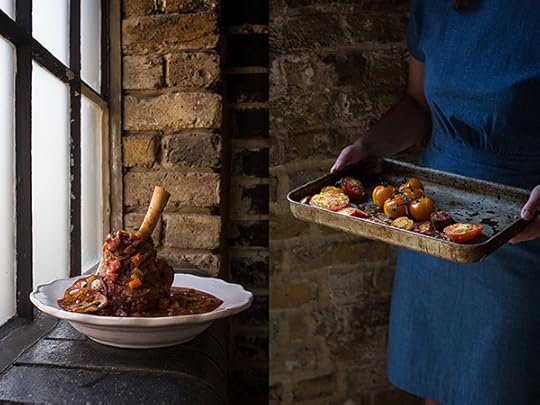
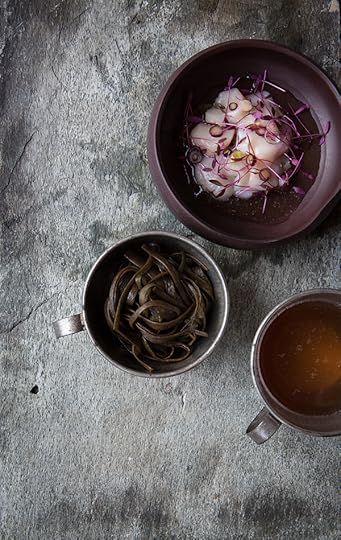
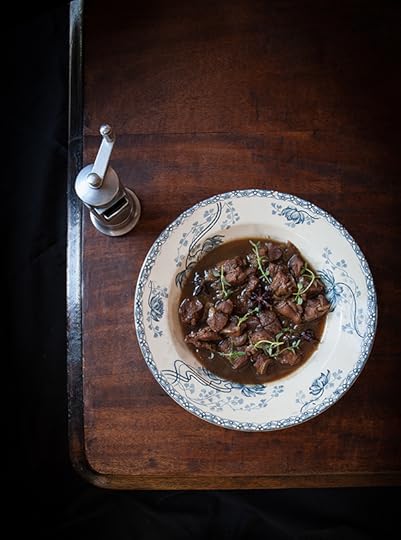
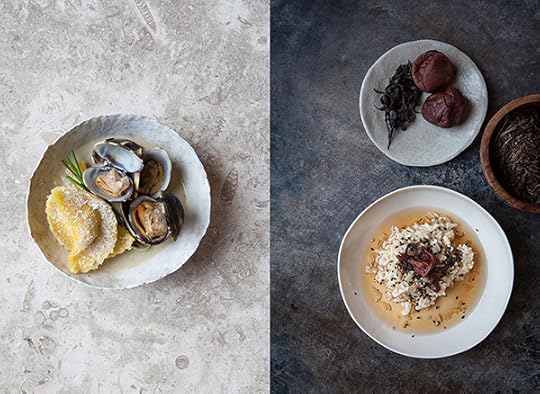
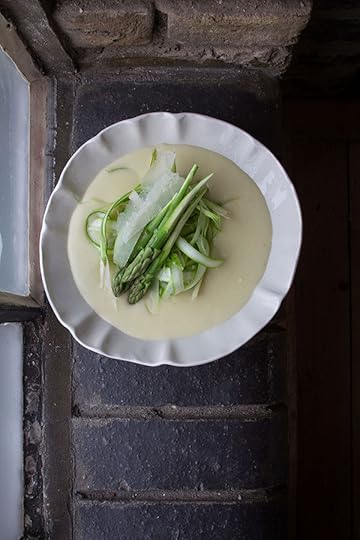 The giveaway closes 15th of october! To win, just leave a comment below and tell me about your all time favourite soup! The winner will be notified on this page so check back to contact me with your address so the book can be sent to you. The book comes with a wooden spoon, an orange tea towel - seen in the picture - and two packs of spices! Please note the book I'm giving away is in Dutch not in English.
The giveaway closes 15th of october! To win, just leave a comment below and tell me about your all time favourite soup! The winner will be notified on this page so check back to contact me with your address so the book can be sent to you. The book comes with a wooden spoon, an orange tea towel - seen in the picture - and two packs of spices! Please note the book I'm giving away is in Dutch not in English.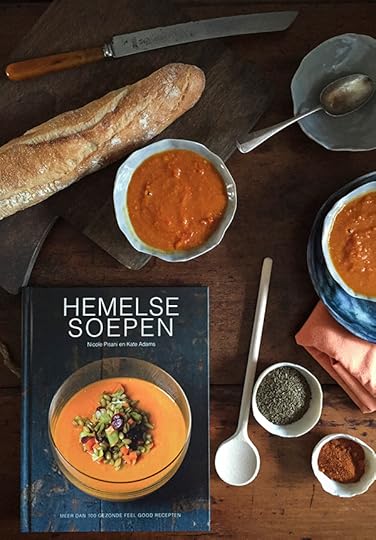
Disclaimer // This is in no way sponsored content.
Please note the book I'm giving away is in Dutch not in English. Giveaway only open to people from Holland and Belgium (because book is Dutch)
Regula
Published on October 04, 2015 06:25
August 27, 2015
The perfect scone is a joyeus thing
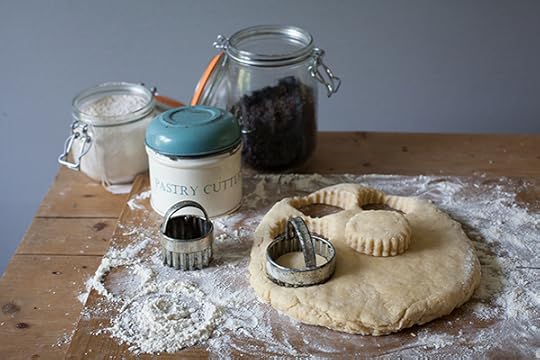
While I am wondering where summing is hiding, and rain is dripping down on my evergreen garden, it feels like the perfect time to start baking scones for tea. How else will you lock out the dreariness that comes with the looming end of joyeus long days, summer dresses and dainty shoes. There has to be tea, and something to go with it.
Tea was introduced to England by Catherine of Braganza, the Portuguese wife of Charles II, in the mid 1600s. Her dowry included a chest of tea.
It isn't certain when exactly the afternoon tea ritual was introduced. The most popular tale is that the 7th Duchess of Bedford had invented it in the 1840’s to fight a ‘sinking feeling’ during the late afternoon. Knowing that in the 18th century people had to wait for dinner until eight o’ clock after having breakfast, I would have had many sinking feelings in the afternoon as well.The Duchess would have had a tray with tea, bread and butter in her room in the afternoon and soon she started to invite friends to have tea and refreshments with her as well.By the 1880’s it became a social event and soon the etiquette surrounding a proper teatime occasion was born.
There should be fresh water in the teapot at all times, and loose-leaf tea is believed to be best. The tea caddy should always be placed closest to the host to show that she or he is in charge. On the tea tray should be the teapot, a sugar bowl with sugar tongs or a spoon if cubes aren't used, a milk jug, a tea strainer, a bowl for the used tea leaves, a dish with lemon wedges, a lemon fork and a pitcher of hot water to dilute the tea if a guest would require it. On the tea table: teacups and saucers, forks and spoons, small cake plates, napkins - preferably linen. A plate filled with sandwiches, warm scones and small cakes. A pot of the best jam, double cream or clotted cream each with a spoon.
Then there's that other thing, 'the cream or jam first' debate, that Devon and Cornwall have been fighting over for decades. I guess it is no longer about what's proper but how one likes his scone. I like to break my scone in pieces bit by bit, then I spread on a layer of jam (and when that jam is home-made raspberry jam it can be some kind of heaven) then spoon on a generous dollop of clotted cream.
I believe a scone shouldn't be too sweet, that way you can generously spread it with cream and jam without feeling too guilty or going into a sugar coma after 1 scone.The secret to the best risen scone is not to overwork the dough and not to turn the cutter while cutting out your scones.
This is my perfect scone recipe, I like them rough instead of soft, with a crumbly outside and a soft inside. Just like I remember my first scone and the scones I enjoy most at my favourite tea-room.


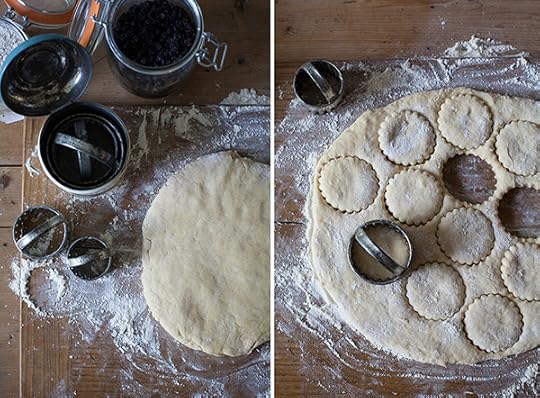
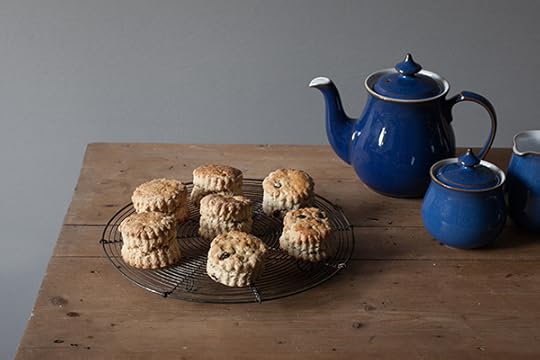
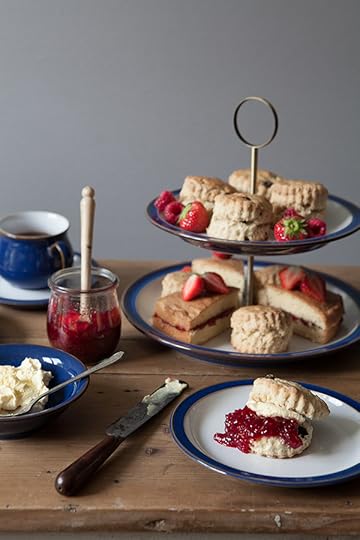
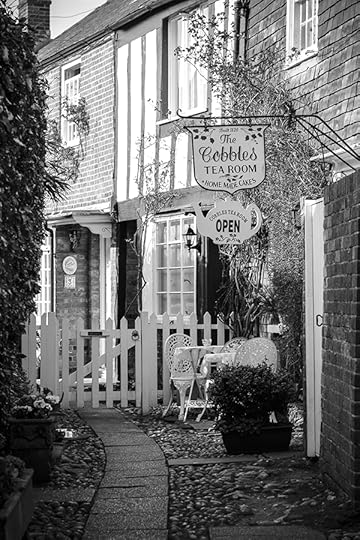 Makes 10-12 scones
Makes 10-12 scones450g self raising flour150 g unsalted butter - room temperature40 g sugar2 medium eggs, beatena tiny pinch of salt6-8 tablespoons of milk1 egg, for egg washing
Preheat the oven to 220°C/425°F/gas mark 7
Line two baking trays with baking parchment.
1. Put the flour into a bowl and add the butter and rub it in until the mixture resembles breadcrumbs. 2. Stir in the sugar. 3. Add the egg and gradually add the milk stirring it in until you have a soft, slightly sticky dough.4. Turn the dough out on to a generously floured working surface and gently knead it for a minute until it ceases to be sticky but still soft. 5. Now flatten it to a thickness of 2cm. It is better to do this with your hands as opposed to a rolling pin, this will help the scones rise better.6. Use a 5cm (or use a larger one for larger scones) cookie cutter to stamp out the scones by pushing it straight down into the dough without turning it, then lift it straight out. This will provide a better and more even rise as well.7. Push the leftover dough together and knead lightly, add currants if you like and flatten again and cut out more scones.8. Arrange the scones on your prepared baking tray and brush the tops with beaten egg. 9. Bake for 10 to 15 minutes in the middle of your oven until risen and golden.10. When ready transfer to a wire rack to cool. When cooled, cover them with a tea towel to keep them nice and moist.
Serve warm, reheated in a warm oven, or cold, with clotted cream or whipped double cream and the best raspberry jam you can find or freshly crushed raspberries ...
You can freeze scones perfectly, just defrost the evening before in the fridge and warm as suggested above before serving.
Part of this article first appeared on the Denby UK Blog 10/08/15
Enjoy!
You might also likeCornish splitsA perfectly simple white loafHot Cross Buns
Published on August 27, 2015 06:52
August 20, 2015
How free range is your bacon?
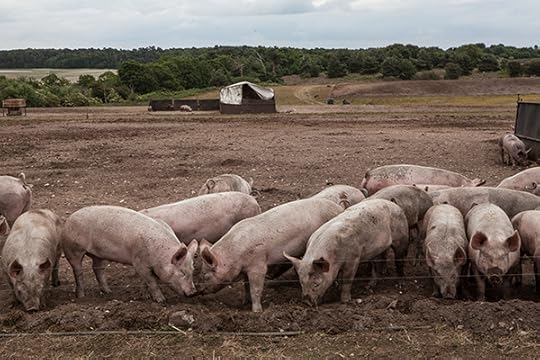 kisses on the free range fieldsIt came as a bit of a surprise to me that less than 3% of the pork in the UK is actually truly 'free range'. You think if you choose for the 'freedom foods' or 'red tractor' label, you're sorted, but no, that doesn't mean your bacon is free range at all.
kisses on the free range fieldsIt came as a bit of a surprise to me that less than 3% of the pork in the UK is actually truly 'free range'. You think if you choose for the 'freedom foods' or 'red tractor' label, you're sorted, but no, that doesn't mean your bacon is free range at all.To learn more, I ventured out to sunny Suffolk to meet up with second generation pig farmer Alastair Butler on their family farm Blythburgh Free Range Pork.
As it turnes out, a lot of the pork we think to be free-range, has actually not had a better life than a pig in an intensive farm. We assume when we spot the label 'outdoor bred' or 'outdoor reared' that it is free-range, only it isn't.
First we have to understand how pig farming works.
There are two stages or herds, the 'breeding herd' - these are the sows and the newly born piglets, and the 'finishing herd' where the piglets go after they are weaned which is after about four weeks of age.
In the majority of the higher welfare farms, the high welfare terminology only applies to the first herd, the sows and their babies.
Outdoor bred and outdoor reared is NOT free range pork.
Outdoor bred: this means the breeding herd is kept free range but the after the piglets are weaned, they are moved indoors to the finishing herd where they are intensively reared. The pork from these pigs will not be any different from your average intensive farm.
Outdoor reared: here the breeding herd is free range too, and the finishing herd is kept in a semi outdoor arrangement of tents or huts. The pigs do not have free access to the outside, and are confined to these huts and tents at all times. Alastair refers to this arrangement as ‘intensively reared outdoors.’
Free range: here the breeding herd is free range, and the finishing herd is kept in an even larger free range space. This is the only true higher welfare farming system.
Blythburgh is one of the largest free range farms in the UK, this means that the pigs have an incredibly large amount of land to roam freely. The animals grow slower, which means the fat has been around the muscle for longer and therefore delivers more flavour.
But for Alastair the welfare of the pigs is what's most important, he steps into the field with his dad and nearly all of the pigs in the field come storming towards him to see what is going on and have a sniff on the farmers leg and shoes. "This is what it's all about" he says "pigs showing their natural behaviour which is that they are incredibly curious and clever animals".
I asked him if he is still smitten with the breeding herd after years of seeing piglets being born, and he tells me that he still loves everything about the breeding herd, but the fact that they have to keep the sows on a more confined paddock means he prefers to visit the finishing herd which looks to me like a gang of friends having a nice play in the sand rather than a bunch of farm animals being finished for slaughter.
The natural behaviour of a pig is to root in the soil and eat the mud, they love a good dust bath or wallow in the muddy pools and enjoy a good run. Imagine if you would place an animal like this on a concrete floor, with no light apart from a couple of industrial lights if they are lucky. No fresh air, nothing. Farrowing crates contain the sows, they are so tight that they can not turn, they can not stand, they just have to lie there. Piglets are taken from these animals after birth, while pigs are known for being good mothers, imagine what the animal must be feeling. And that is what is important, we can't ignore that animals have feelings. Farm animals are no different from pets. It is important to take a stand against intensive farming, and eat less meat, but choose to buy high welfare meat.
Ask your butcher where the meat comes from, investigate by looking up the farms website to see that you are getting your money's worth in free range meat.
There is no room in this day and age for animal abuse, so find a free range source for your meat.
From farm to plate
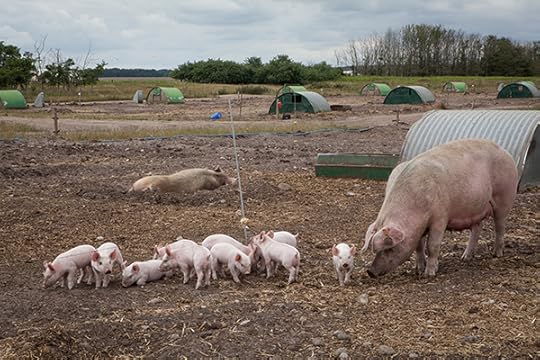 The breeding herd
The breeding herd
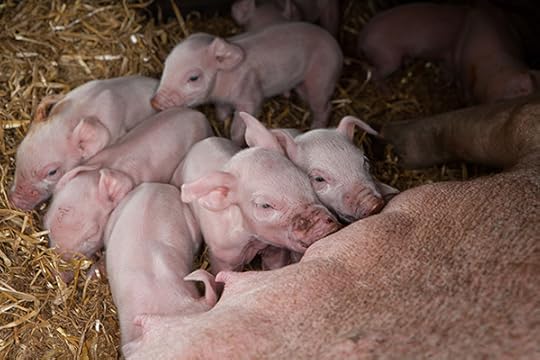 A happy mama and her babies fighting over the best teat
A happy mama and her babies fighting over the best teat
 And suddenly another mama started farrowing, she covered her piglets in straw to keep warm
And suddenly another mama started farrowing, she covered her piglets in straw to keep warm
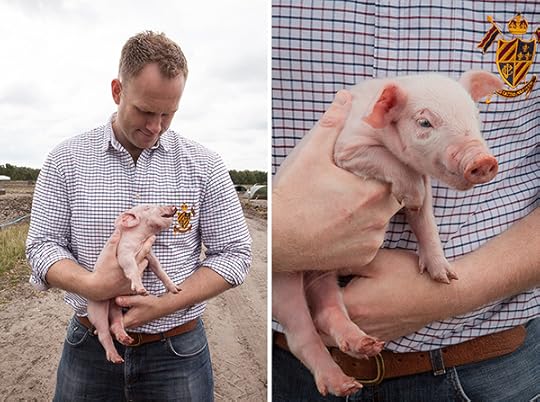 Alastair Butler and his piglets. I got to hold her too, she fell asleep on me.
Alastair Butler and his piglets. I got to hold her too, she fell asleep on me.
 A curious bunch - the finishing herd.
A curious bunch - the finishing herd.
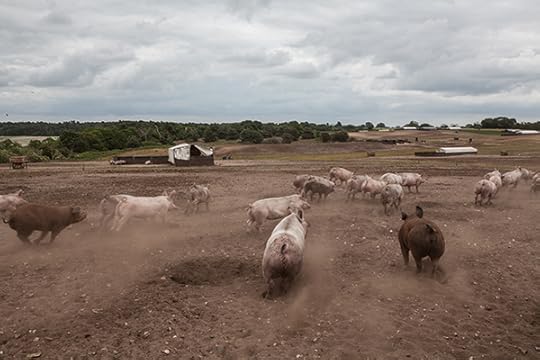 Didn't I say they love a good run?
Didn't I say they love a good run?
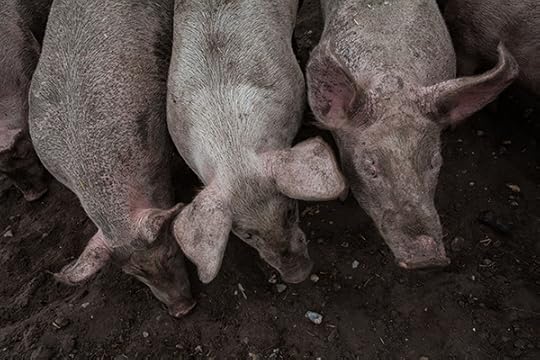 And that they love to eat and root around the mud?
And that they love to eat and root around the mud?
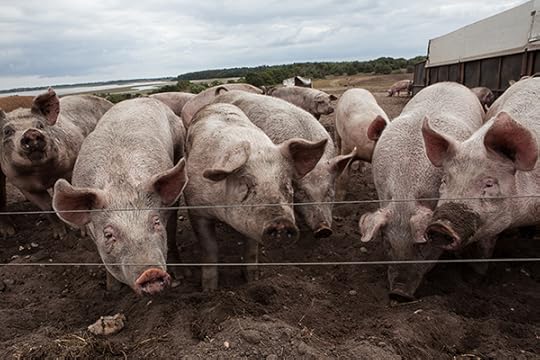 Are you looking at me? Well you're looking at us human!
Are you looking at me? Well you're looking at us human!
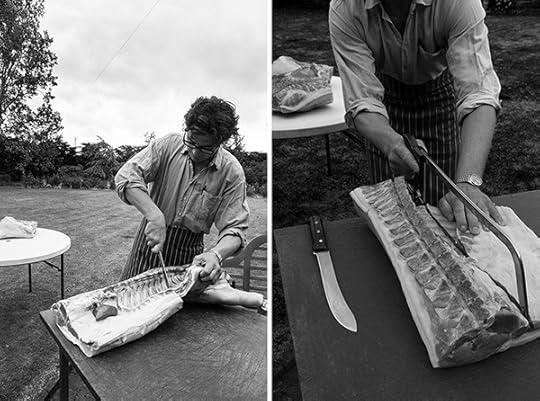 Slaughtered and butchered by Gerard King.
Slaughtered and butchered by Gerard King.
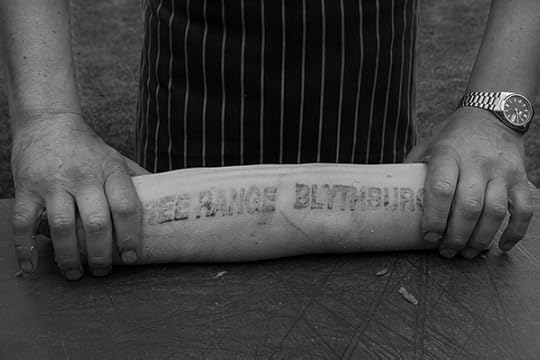 The mark, so you know what you get.
The mark, so you know what you get.
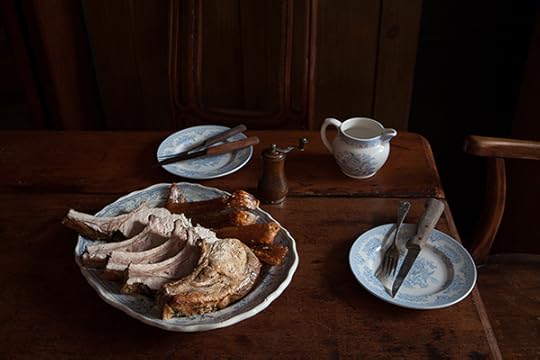 The final stage - the table.
The final stage - the table.Thank you very much for inviting me to your family farm Alastair, and for the beautiful pulled pork lunch your mother made us. Thanks Gerard King from craft butcher Salter and King for a butchery demonstration to round up the day and the process from birth to slaughter. Good meat can't be taken for granted, it has to be respected.
Recipe for the roast coming soon.
My views are my own.
Published on August 20, 2015 03:07
July 14, 2015
Cherry tart and prostitution
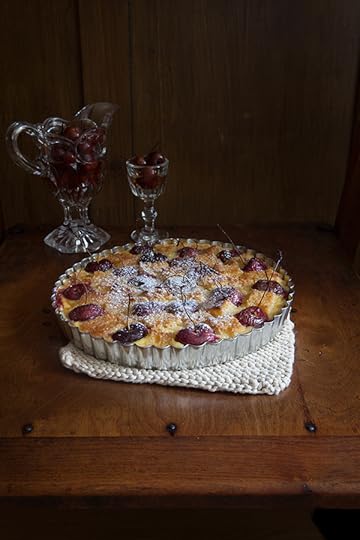
When I was a little girl my parents and I used to travel around Hungary in the summer. I can still remember the warm climate, and the little dresses I wore, many of which I have in a shoe box upstairs. What I also remember is the Bed and Breakfast, back then called 'Zimmer frei' in Hungary, which was run by an old couple. The woman looked a lot like my aunt and the man I can't remember much. Their house was large for Hungary and by a main road, not far from a little restaurant by the river Danube where I always ate a very good omelette for supper.
Our time with the old couple was like staying with your grandparents, sure communication was complicated, they spoke a little German, so did my parents, and I as a four year old strangely enough spoke a good word of German too. They were loving people and love can be shown without the language barrier. Each day we entered our room, the old lady surprised us with a large stone bowl of the most plump cherries I have ever seen. As a child, and a picky eater, those cherries were some kind of heaven. Food I knew, and was so expensive at home that I could never really eat so many that my fingers would be stained in cherry juice.
And every day a bowl appeared, and every day we were greeted by the most loving smiles and gestures by these two wonderful people.
Two years after our last visit to the old couple's Zimmer Frei we decided to do a detour and stay with them for a couple of nights. I requested it especially because I was eager to see my Hungarian grandparents as they had become to be for me. My parents too had never encountered such kindness and were eager to stay there again too.
So we drove to the rather large Hungarian house and as we parked the car I ran towards the door where the old lady - she must have been in her early seventies - was sitting in her chair.
But while I was running towards her the first thing I noticed was the anxious look in her eyes, and then the dress that she wore. As before she always wore granny clothes, now she was wearing a black embroidered dress with a deep decollete and very large earrings.
Anxious as she was, but really happy to see us, she told my parents that she would love it if we would stay but that she was no longer a Zimmer Frei since her husband had died the year before.
I wondered what the young girls were doing there if she wasn't offering lodgings anymore, and somehow, while she was showing us to our room and I saw how the house had changed and lost all its granny appeal, I knew. I knew without without having the knowledge of years.
Heartbroken and realising that there might not be a bowl of cherries in our room each day, and hurt by the uncomfortable anxious look in my Hungarian grandma's eyes we said we'd go for dinner and then come back to decide if we would stay.
The granny had tears in her eyes, and I felt like she was holding on to the summers and the bowls of cherries as much as I was doing. But those times were gone. The light had gone out in the rather large Hungarian house. It was replaced by sorrow, regret, and a need for survival.
So we ate an omelette at the restaurant by the river, and my parents gave me the choice on whether to stay at the granny's house. Too young to understand what was happening at the house, but old enough to feel there was something wrong, I told them that I felt that it wasn't right for us to stay there.
So we drove back to the granny's house, and said our goodbyes, granny still trying to convince us we were so very welcome. But I was feeling so very sad. I could not understand what had happened and somehow I knew that by staying we would not only make her happy, we would also maker her very sad.
She had made her choice, and there would be no more bowls of cherries.
I hope she was at peace at the end of her life, so very long ago.
In her memory I have prepared this cherry tart, inspired by 18th century tarts, some of which you'll find in my upcoming book. It's a perfect tart to make when you have leftover sponge cake, that way you don't need to bake a cake especially. The tart has a pleasant texture, though not like the tarts you are probably used to. Let me know if you've tried it!
x R
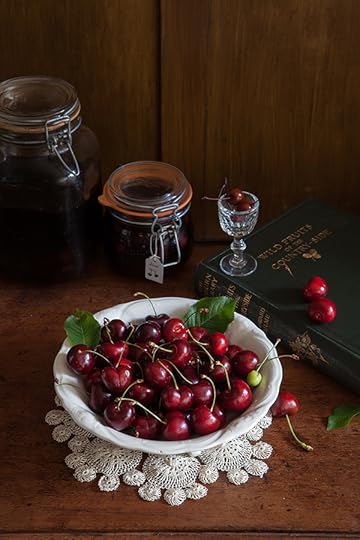
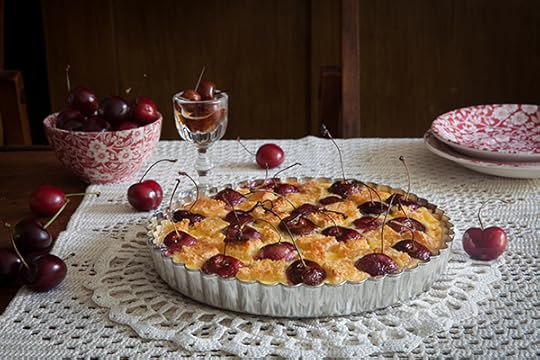
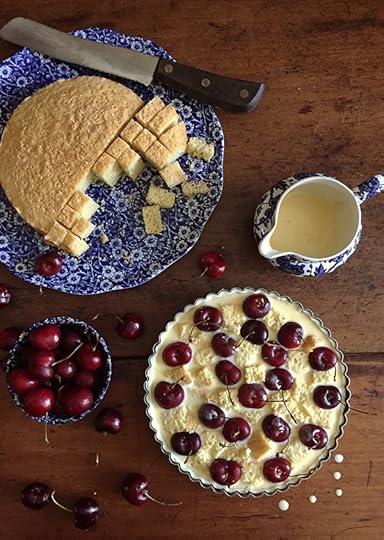
Cherry tart with curstard and sponge cake
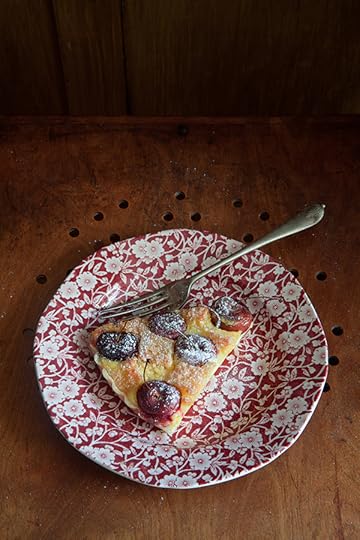
What you need
Shortcrust pastry
180 g white flour100g cold butter20 g icing sugartiny pinch salt1 egg yolk1 tbsp of cold waterCustard
250 ml cream3 egg yolksa blade of macea stick of cinnamon1tbsp of raw cane sugarFilling
Sponge cake, preferably stale2 tbsp of brandy (optional)a punnet of cherries2 tbsp of unsalted butter - or bone marrow22-24 sized pie pan or plate
Method
For the pastry
Take your butter and cut it into small pieces.
Put your flour into a food processor and add the butter and sugar.Pulse for 8 seconds until your mixture has a bread crumb consistency.
To do this by hand, just use a blunt knife, cutting the knife through the butter and flour to work them together to a bread crumb consistency.
Add the water and egg yolk and pulse until you get big lumps, then turn out your pastry and knead briefly until smooth.
Now pack the pastry in cling film and leave in the fridge for 30 minutes.
Preheat your oven to 180-190C
Make the custard by bringing the cream to a gentle simmer with the sugar and spices. In a bowl beat the egg yolks, pour a small amount of warm cream into your egg yolks and whisk thoroughly. This prepares your yolks for the hot liquid and will prevent it from curdling. Now start adding the rest of the cream, whisking until it is all incorporated. Allow to cool, then strain out the spices.
Cut your stale sponge cake in small dice and drizzle over the brandy.
Blind bake your pastry case in the middle of your oven for 25 minutes, allow to cool.
Now arrange your cherries and cake into the tart casing, placing a piece of cake in between each cherry. You can stone your cherries, or not, I left the stones and stalks on this time, but you can remove them if you are going to serve children, the tart eats easier of course without the stones.
When your tast casing is filled with cherries and cake, arrange little knobs of butter randomly in between your cherries and cake.
Now carefully pour in your custard, making sure it is evenly spread.
Place the tart in the middle of your oven and bake for 30-40 minutes or until nicely golden brown.
Dust with icing sugar, serve cold or lukewarm.
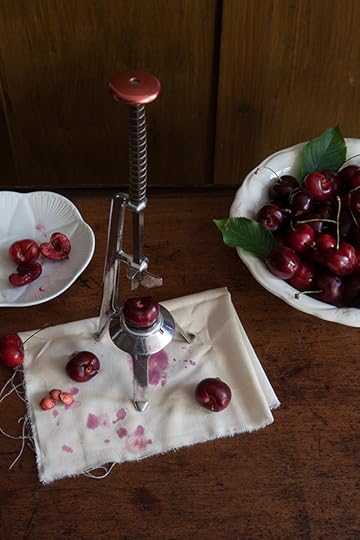
You might also enjoy these:Kentish Cobnut and apple tart >Tudor prune tarts >Treacle tarts and Treacle miners
Cherry brandy >
Published on July 14, 2015 09:24
July 12, 2015
Summer reading 2015
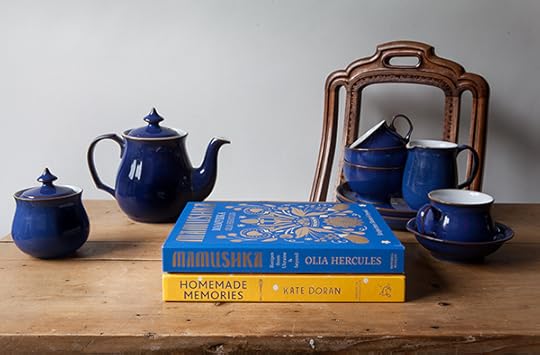 I know, summer has started two weeks ago, but to be fair I have a valid excuse for being late with my 'summer reading' post... I needed to finish my own book!
I know, summer has started two weeks ago, but to be fair I have a valid excuse for being late with my 'summer reading' post... I needed to finish my own book!Anyway we are in the editing and layout fase in English and Flemish so the book isn't completely finished yet, but it has been written and I have made all the photographs so that part is done.
The past months there were quite a few interesting books coming out, but I have chosen just four of them, because these are the ones I would buy or have bought. These are four different books, so I am confident that there will be a book for all of you in this list.
Cooking & Dining in Tudor & Early Stuart EnglandSwallow This, Serving Up the Food Industry's Darkest SecretsHomemade MemoriesMamushka
Mamushka by Olia Hercules
I was eagerly waiting to get my hands on this book because the author Olia and I have known each other for over 3 years now on instagram and I watched her going from chef to food stylist, and from food stylist to the Observers 'rising star'. Olia Hercules, who doesn't only have the most wicked name, is also a very warm and generous person. It shows in her book where she shares the food of Ukraine and beyond, teaching us about a cuisine that hasn't really been explored yet in books.
I can't wait to try the Ukrainian 'narcotics', and Tartar lamb turnovers. And the Poppy seed roll brings up memories of my childhood travels around the Czech republic and Hungary where this dish is also a favourite. The watermelon skin jam is just intriguing as are the fermented tomatoes. The Moldovan giant cheese twist calls for a theatrical way of stretching a super thin dough, but Olia assures us we can do it and tells us we should attempt it when in a playful mood.
Other than providing us with many new and exciting traditional soviet dishes to have a play with, we also catch a glimpse of her family as the book travels to Ukraine and visits her home turf. The photographer of this book Kris Kirkham captured the mood of Olia's life perfectly and adds to the storytelling as photography should do.
Why buy? It's a whole different and exciting cuisine to explore, and the book is aesthetically beautiful and more importantly, it's very real and not at all staged like so many books are these days.
Childhood nostalgia:
Homemade memories by Kate Doran
I don't know about you but when I saw the cover of this book I was sold. I have a weakness for Jaffa Cakes and as Kate, the author explains, the passion for many of these childhood favourites kinda cools when you look on the back of the pack and read about all the stuff they put in there.
But I'd never considered making my own Jaffa cakes, fearing it would be a right faff and wouldn't taste the same as the 'real deal' or rather the 'shop bought'.
Most of the recipes don't conjure up childhood memories for me as they are mostly British treats, but then the book reads like a childhood memory and Kate's short stories with each chapter and recipe surely add to the story of this book. You know I wish these were my childhood treats! What an array of gorgeous things. I can't wait to start baking from this book when I finally have some time to bake things that aren't related to my book anymore.
Why Buy? Firstly I would say Jaffa Cakes, but that's just me. The book is beautiful and I believe it would bring lots of joy to families with children and to grown up children too. We all need a Caterpillar cake or Jammie Dodgers in our life. And did I mention Battenberg cake? Oh yes that too.
The truth is out there:
Swallow This, Serving Up the Food Industry's Darkest Secrets
by Joanna Blythman
I met Joanna Blythman two weeks ago on the Great Taste Award judging where we always meet, she asked me if I was enjoying her book. I said to her 'It's awful! I mean, not your writing, but it's just awful and it smacks me in the face'. Joanna smiled and understood what I was trying to say. 'Yes - she said - it is awful and you would probably have to put it down at times'. And she was right. Swallow This is a book which is really hard to swallow because in it Joanna goes undercover in the food industry and uncovers that even the most basic of products have been adulterated. Butter flavour, strawberry flavour, and vanilla that hasn't even a drop of the original in its ingredients list. And then there is the ludicrous way in which a basic frozen pizza is created, the base is made in x country and frozen, then shipped to x country for tomato sauce to be added and then another location adds vegetables and cheese. When your frozen pizza is ready and boxed, it can have travelled more than you have in two years time. Do we really want that? In a time when food miles are on every food conscious person's mind? What you are thinking when you picture processed food is only the tip of the mountain. The valley goes deep and dark and Joanna shows us the truth, and although we want to run and hide and never hear these awful stories again... We can't ignore what is in this book, and we have to think twice about buying that healthy looking fruit salad that has been sprayed to stay 'fresh' for days, or those Feta, with Glucono-Delta-Lactone which will never go off. Food has become science, and we're two seconds away from eating flavoured plastic and artificial meat. This book reads like a horror movie, but sadly this isn't fiction.
For an extract of the book published in The Guardian follow this link >
Why buy? Don't you want to know how you can avoid consuming adulterated food? Don't you want to know what is in your food? This book is an eye opener and goes much further than Michael Pollan has ever done.
Everything you ever wanted to know about the food in this period:
Cooking & Dining in Tudor & Early Stuart England by Peter Brears
Peter Brears' new book was highly anticipated by me for a while, it was due publication last year but came out in februari this year. If you just gaze upon this magnificent and especially huge tome of Brears you understand why the book was late. Brears spent ten years writing this book, so a few months later wasn't going to make a difference, except for those people like me constantly checking the Prospect books site to see if it has come out. Imagine my delight when Tom Jaine from Prospect emailed me to say it was finally available to buy. This is the follow-up to Brears' volume about food in the Middle Ages, a book I mentioned in my 'Best food books' list (find it here >). The period covered in this book is a time when new foods from the New World were starting to influence English food. The book starts with the reign of Henry VII and covers dining and practical arrangements and techniques in the kitchen and dining hall up until Charles I. If you are a geek like I am, this book is for you. The words in the book are illustrated with illustrations made by Brears himself and explain us the system of The Counting House to the Buttery and the Pantry.
Why Buy? If you want to learn about Tudor and Early Stuart cooking of course. And also if you are eager to reproduce recipes from this period. This book is an absolute delight and a bible full of knowledge about food of times gone by. Although for me this book makes excellent bedtime reading, it is a huge and heavy volume so make a cup of tea and enjoy it in the comfort of your favourite comfortable chair... maybe with a cushion to support it.
The end
This is it for this years summer reading, these are only four of many great books out there. Rachel Roddy's Five Quarters: Recipes and Notes from a Kitchen in Rome just came out and is also still on my list to buy and Zinziber, sauces from Poitou is another title from Prospect books which I have been waiting for for some time now. Let me know if I missed some great books!
* I received a review copy from 'Swallow This' and 'Homemade Memories'. The other two books were ordered and payed for by me. All views are my own.
Further reading: 'Best food books' list (find it here >)
Published on July 12, 2015 04:35
June 14, 2015
A surcharge on sugary drinks versus IKEA fruit water
Ikea, making us believe that their new fruit waters are healthier than their sugary fizzy drinks, because they contain 50% less sugar.
Meanwhile across the channel, a chef has had enough and is campaigning for a tax on sugary drinks - all sugary drinks, even the ones with 50% less sugar.
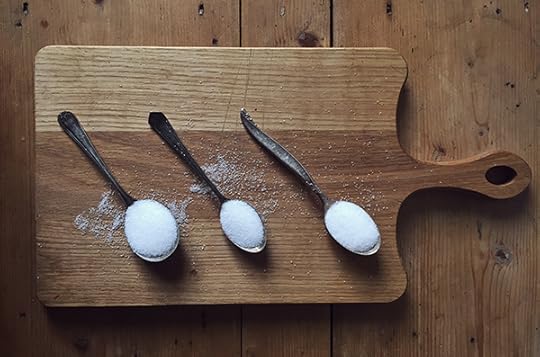
I thought the press might be all over this, I thought it would explode on health blogs and yet... all remained quiet. As I am getting ready to attend a food symposium in the UK with the theme 'Food and Communication' I found it fitting to have a rant about how this communication by IKEA* is misleading us all.
From september 2015 they will ban all sugary fizzy drinks from their restaurants. That's the headline and that's the lie. Proudly they are replacing their imitation Pepsi and 7up with more healthy fruit waters which contain only half the sugar. Half the sugar. That's still too much sugar.
The World health organisation (WHO) say that we ideally should be consuming no more than 6 teaspoons of sugar a day. **Regular fizzy drinks contain up to 6 teaspoons per 330ml serving. That's your daily sugar intake in one glass of sweet drink. That is bad.
So if IKEA's fruit water contains 'only' half the amount of sugar of your average fizzy drink - it still contains about a whopping **3 teaspoons of sugar.
When having one glass of IKEA fruit water means you have consumed half the daily recommended amount of sugar. And you know what? They offer FREE REFILLS! So you can have more!
Firstly their fruit waters aren't healthy, nor are they more healthy because they contain 'only' 50% the amount of a regular pop per serving. Secondly they are motivating people to refill their cup at self service machines, so people can have another 3 teaspoons of sugar diluted in water with natural flavourings.
My advise to IKEA.
Serve water with real fruit, just fruit - no added sugar, no added colourings.
How do you do this?
Fill a jug or a barrel with water, just water, and just toss in sliced cucumbers, apples, strawberries or whatever fruit. Then and only then you have FRUIT WATER, and not fizzy drink with natural fruit flavours and only half the sugar.
I understand that this would make your system of free refills at a machine impossible, but I think we are outgrowing the machines and are yearning for human contact again. Then and only then will you be making the change you are shouting about right now. Then and only then will you be truthful with your customers. Right now, you are contributing to a world-wide problem of children and adults being overweight due to an extreme sugar intake. All because people buy foods and drinks which are low in sugar, to then consume double.
A surcharge or tax on sugary drinks
The contrast with another news item this month is stark.
Jamie Oliver is making good of his crusade to tax sugary drinks and is putting a surcharge on sugary drinks in his restaurants. The money from the surcharge will go to a charity that supports children's health across Britain.
He told the Sunday Times: 'I was born into the restaurant industry and I truly believe that by joining together on this issue we not only send a powerful and strong message to government but we also have the potential to make a longlasting legacy that could ripple across the world.
'I've seen first-hand the heartbreaking effects that poor diet and too much sugar is having on our children's health and futures. Young children are needing multiple teeth pulled out under general anaesthetic and one in three kids [is] now leaving primary school overweight or obese.
'Soft drinks are the biggest single source of sugar among school-age kids and teenagers and so we have to start here.' The chef said an explanation of the sugary drink levy will be printed on all his menus and waiting staff will be able to offer alternative healthy drinks for children.'
Quite a different story from, we're cutting down on sugar but you can still go for a refill so you can have all the sugar you want.
What Jamie Oliver is doing is being honest about the fact that the sugary drinks on his menu aren't healthy. And by adding an explanation to why he is adding the surcharge he is educating people rather than trying to ban the sugary drinks all at once. Banning something will only make people want it more, but telling them about the dangers of excess sugar intake will maybe make people want to give up, or reduce their consumption of sugary drinks. What Ikea does is claiming their sugary drinks are healthy, and that is where they go wrong.
Further reading/watching
The Truth about Sugar BBC 2015 >
How much sugar is in your fizzy drink >
World Health Organisation recommends adults should have no more than 6 tsp of sugar a day >
Tax on sugary drinks to reduce obesity a study says - The Independent >
In Flemish
Ikea schrapt fristdrank van het menu (en vervangt het met fruitwater met 50% minder suiker) De Standaard >
Jamie Oliver heft belastingen op frisdrank - De Standaard >
Sources: Sunday Times, The Independent, Eater, De Standaard, BBC, WHO, press release IKEA
*This post is about IKEA BELGIUM, I have no idea what the situation is in other countries.
** I do not know how many teaspoons of sugar their fizzy drinks contained so used an average quantity. I will of course alter the numbers if they become known to me.
Apologies to my readers for going off-topic on this blog, but I truly believe you can't be a foodie without being a food activist.
Meanwhile across the channel, a chef has had enough and is campaigning for a tax on sugary drinks - all sugary drinks, even the ones with 50% less sugar.

I thought the press might be all over this, I thought it would explode on health blogs and yet... all remained quiet. As I am getting ready to attend a food symposium in the UK with the theme 'Food and Communication' I found it fitting to have a rant about how this communication by IKEA* is misleading us all.
From september 2015 they will ban all sugary fizzy drinks from their restaurants. That's the headline and that's the lie. Proudly they are replacing their imitation Pepsi and 7up with more healthy fruit waters which contain only half the sugar. Half the sugar. That's still too much sugar.
The World health organisation (WHO) say that we ideally should be consuming no more than 6 teaspoons of sugar a day. **Regular fizzy drinks contain up to 6 teaspoons per 330ml serving. That's your daily sugar intake in one glass of sweet drink. That is bad.
So if IKEA's fruit water contains 'only' half the amount of sugar of your average fizzy drink - it still contains about a whopping **3 teaspoons of sugar.
When having one glass of IKEA fruit water means you have consumed half the daily recommended amount of sugar. And you know what? They offer FREE REFILLS! So you can have more!
"Ikea schrapt frisdrank van het menu"
(Ikea bans sugary fizzy drinks from menu)The communication to the world is that IKEA is trying to get a more healthy reputation... I think they are misleading the consumer with it.
Firstly their fruit waters aren't healthy, nor are they more healthy because they contain 'only' 50% the amount of a regular pop per serving. Secondly they are motivating people to refill their cup at self service machines, so people can have another 3 teaspoons of sugar diluted in water with natural flavourings.
My advise to IKEA.
Serve water with real fruit, just fruit - no added sugar, no added colourings.
How do you do this?
Fill a jug or a barrel with water, just water, and just toss in sliced cucumbers, apples, strawberries or whatever fruit. Then and only then you have FRUIT WATER, and not fizzy drink with natural fruit flavours and only half the sugar.
I understand that this would make your system of free refills at a machine impossible, but I think we are outgrowing the machines and are yearning for human contact again. Then and only then will you be making the change you are shouting about right now. Then and only then will you be truthful with your customers. Right now, you are contributing to a world-wide problem of children and adults being overweight due to an extreme sugar intake. All because people buy foods and drinks which are low in sugar, to then consume double.
A surcharge or tax on sugary drinks
The contrast with another news item this month is stark.
Jamie Oliver is making good of his crusade to tax sugary drinks and is putting a surcharge on sugary drinks in his restaurants. The money from the surcharge will go to a charity that supports children's health across Britain.
Jamie Oliver says that he expects the surcharge to raise £80,000 over the next year. He will donate the money to Sustain, a charity that "support's children's health food initiatives across Britain.
He told the Sunday Times: 'I was born into the restaurant industry and I truly believe that by joining together on this issue we not only send a powerful and strong message to government but we also have the potential to make a longlasting legacy that could ripple across the world.
'I've seen first-hand the heartbreaking effects that poor diet and too much sugar is having on our children's health and futures. Young children are needing multiple teeth pulled out under general anaesthetic and one in three kids [is] now leaving primary school overweight or obese.
'Soft drinks are the biggest single source of sugar among school-age kids and teenagers and so we have to start here.' The chef said an explanation of the sugary drink levy will be printed on all his menus and waiting staff will be able to offer alternative healthy drinks for children.'
Quite a different story from, we're cutting down on sugar but you can still go for a refill so you can have all the sugar you want.
What Jamie Oliver is doing is being honest about the fact that the sugary drinks on his menu aren't healthy. And by adding an explanation to why he is adding the surcharge he is educating people rather than trying to ban the sugary drinks all at once. Banning something will only make people want it more, but telling them about the dangers of excess sugar intake will maybe make people want to give up, or reduce their consumption of sugary drinks. What Ikea does is claiming their sugary drinks are healthy, and that is where they go wrong.
Further reading/watching
The Truth about Sugar BBC 2015 >
How much sugar is in your fizzy drink >
World Health Organisation recommends adults should have no more than 6 tsp of sugar a day >
Tax on sugary drinks to reduce obesity a study says - The Independent >
In Flemish
Ikea schrapt fristdrank van het menu (en vervangt het met fruitwater met 50% minder suiker) De Standaard >
Jamie Oliver heft belastingen op frisdrank - De Standaard >
Sources: Sunday Times, The Independent, Eater, De Standaard, BBC, WHO, press release IKEA
*This post is about IKEA BELGIUM, I have no idea what the situation is in other countries.
** I do not know how many teaspoons of sugar their fizzy drinks contained so used an average quantity. I will of course alter the numbers if they become known to me.
Apologies to my readers for going off-topic on this blog, but I truly believe you can't be a foodie without being a food activist.
Published on June 14, 2015 02:59
May 19, 2015
18th century Sweet Lamb Pie
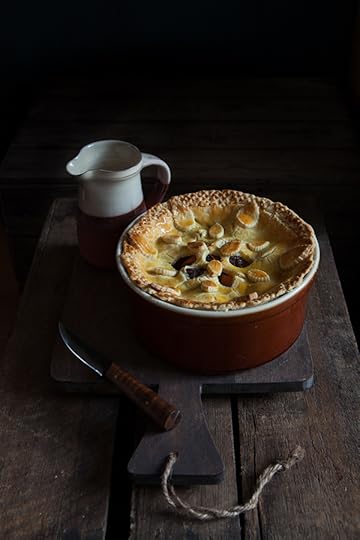
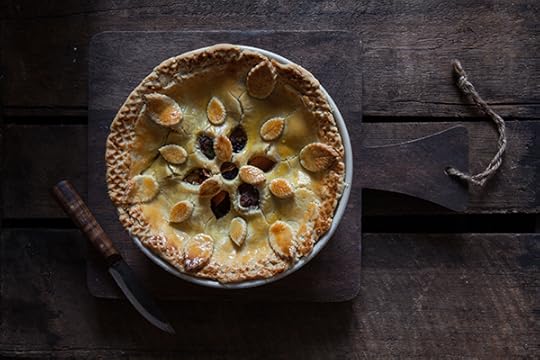
When I tell people about my passion for historical dishes, there are always those who look at me with disbelief and some amusement. They claim those ancient dishes were made of rotting meat masked with an abundant use of spices, or stodgy pottage, all eaten with the hands like barbaric creatures. It can't be good, it can't be imaginative, it just can't be ...
The theory that food in the Middle Ages was highly spiced to mask the flavour of rotting meat has been discarded as pure nonsense in the last ten years. Those who were served spiced dishes were privileged, those cooking with it were the master cooks to kings and queens. People of status that not only could afford this immense luxury, but also had a good supply of fresh meat and fish from their estates and beyond.
Our ancestors - of the elite - had a good understanding about spices, and how to combine them. Those flavour combinations would often taste peculiar to us. Not at all in a wrong way, but in a way that you realise it is a flavour sensation you have never tasted before.
This brings me to how tastes have changed.
Today everything is usually either sweet, salty or spicy. Bitter is making a modest comeback and sour too, but these flavours are seldom combined in our 'modern' European cuisine. It is even so that a lot of our foods are processed in factories which add flavour essences to make the food taste the same every time you prepare it. Of course this doesn't happen when you cook from scratch, but it is an unfortunate fact that people in the UK buy a lot of ready meals. It is a trend that has luckily not taken off in Belgium, but it is very possible we're not far behind. Joanna Blytham recently published a book about these practices in food processing factories, and she rings an alarm bell and employs you to smell your food, to taste, and realise the smells and tastes are not from natural ingredients. This is an evolution, when more people eat processed food, they get an idea about how tomato tastes, and how a beef stew should taste. It goes so far that when those people taste the real thing, they can't take the sourness of a real tomato, the texture of the skin, and they find their own beef stew too bland and wonder where the flavour of the ready meal comes from. It's not tomato, and it's not beef. Butter in buttery pastry is not butter but other fats, with added butter flavour. It might taste like butter, but it might not completely and it might even change your taste and idea of how it should taste all together. I will go into Joanna's eye-opening book in another posting but you get the idea for now. Today many of the people taste food, but don't really taste the produce. Their tastes change. A very simple example is when I give someone a glass of raw milk to drink, I am used to it and drink it all the time, but my guests often can't finish another sip because they find the flavour too 'animal-like'. Most milk you buy in the supermarket to me tastes like white water, but this is how the people think milk tastes like these days.
Eliza Smith's Sweet Lamb pie from 1727 is one of those dishes that really show off the old way of spicing food. The flavours come through in layers if you get what I mean. It is not really sweet, but the spices that are used, nutmeg, mace and cloves were considered sweet spices and used as a sweetener. Sugar is added too, but used rather like a spice. In addition to these spices, currants and candied peel are added to bring extra sweetness. Then also sweet potato is added, and artichoke hearts. The 1727 book also mentions that when artichokes aren't in season, one can use grapes too.
The pie is built with pieces of diced lamb, dusted in the spices, and meatballs made with lamb meat, suet, currants and the same sweet spices with the addition of fresh parsley.
Layers are constructed of lamb, lamb meat balls, sweet potato and artichoke.
When your pot or pie is full, a blade of mace is added and the pie is placed in the oven for just over an hour. Just when you're ready to serve, a 'Caudle' is made, this is a sauce which is added to the pie by pouring it in when you are ready to serve. It is usually there to lift the flavours of the dish. In this case the caudle is made with white wine, lemon juice, a little sugar and a couple of egg yolks.
This sauce gives the dish a little acidic kick and will guaranty you to want to empty the saucepan until the very last drop.
The pie can either be made in a free-standing pie crust like you see in the pictures I took when I was at Food Historian Ivan Day's house, for a weekend of Georgian cooking last year. A hotpot is however another way of making this pie, this is a closed casserole dish used in the North of England, or you can use a deep oven dish and add a pastry lid, which is what I did the last time I made the pie, and what you can see in the first pictures here.
I made this Sweet Lamb pie not too long ago when we had two chefs coming for dinner, I did not know how they were going to react to the flavours of this dish.
Fortunately my friends are all about good, honest and natural food so they were eager to try. And they enjoyed it, one of the duo even asked me if it was okay to lick his plate and clean out the saucepan of caudle.
I say that's mission accomplished, don't you think?
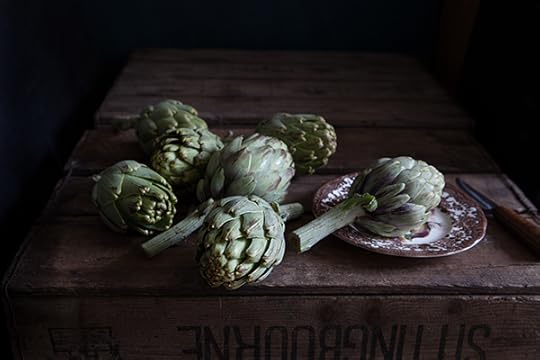
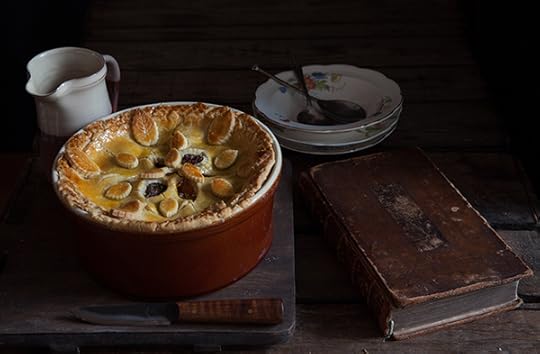
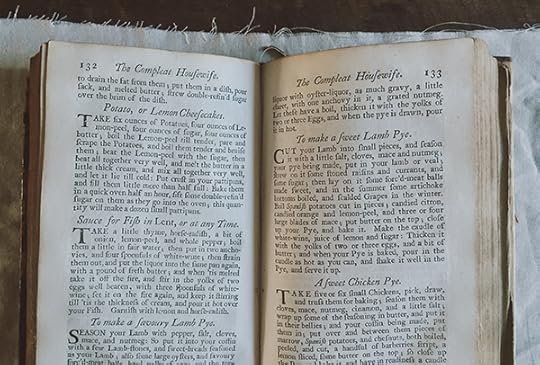
The pie is incredibly flavoursome and eats just wonderful with the different vegetables and meat; the addition of a piece of salty pie pastry is a bonus but not a must if you aren't up to making your pastry, but please don't use shop bought pastry... that is just plain evil and doesn't even contain butter!
I made the pie you see in the pictures above with pastry I had leftover from my recent pastry project... You might have spotted it on instagram.
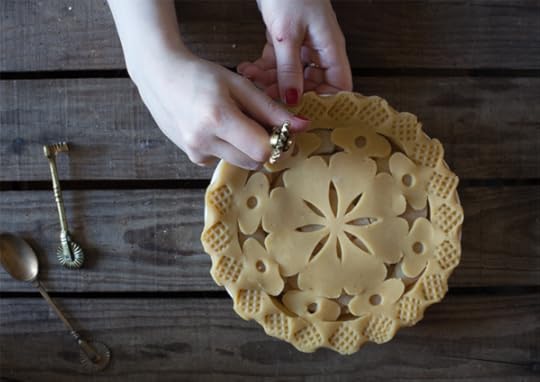
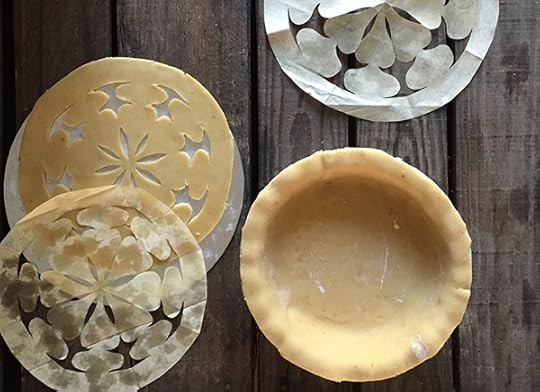
18th century Sweet Lamb Pie
Serves 4
250 g lamb meat from the leg250 g lamb mince (if you buy a leg, you can use the leftover leg to mince)2 large sweet potatoes, parboiled, cut in dice4 small or 2 large artichoke hearts, parboiled, cut in diceor when you don't have artichokes, use a handful of grapes, blanched.1 tsp of ground mace1 tsp of ground nutmeg4 cloves, beaten2 blades of macea generous pinch of good black pepper - or 3 pieces of long pepper, beaten1 tsp each of candied lemon and orange peel, in small cubes50 g of shredded suetfresh parsley cut finely, about 1 tbspcurrants 50 g
For the Caudle
The juice of 1 lemonThe same quantity of white wine1 tsp of sugar1 egg yolka little knob of butter
Preheat your oven to 160° C
Beat your spices, but leave the two blades of mace whole.
Dust the meat with half the spices, add the other half to the minced meat.
Make your minced meat balls with the spices, suet, parsley and 2 tbsp of currants.
Have all your components of the dish ready so you can start making the layers.
Place some meat, meatballs, sweet potato and artichoke into your dish or pastry and strew over some currants and candied peel, continue until the pie is full.
Close the pie with pastry, making a hole for steam, or put the lid on and pop in the middle of your oven for 1 hour to 1hr and 15 minutes. This could be longer, it depends on the quality of your meat, decent meat needs less cooking. So try and taste, when you have a pastry cover, user a skewer to prick to see if the meat is tender.
When ready, take out of the oven and make your Caudle.
Bring your wine and lemon juice to a simmer with the sugar, in a separate bowl, have the yolk ready and add the warm caudle like you would for a custard. Finish with a little knob of butter and warm again over the fire.
Pour the caudle into the pie, and serve. The caudle will mix with your pie juices and create a sauce.
If you're making pastry, this is an easy recipe to try
For the pastry
300g plain white flour100g unsalted butter100g shredded sueta generous pinch of salt125 ml ice cold water1 egg, beaten
Combine the flour, butter, suet and salt in a large mixing bowl and use your fingers to rub the butter into the flour. Keep on doing this until the mixture resembles breadcrumbs.Pour in the water and start pressing the liquid into the breadcrumb-like mixture. Be gentle as you must be careful not to overwork the dough.When you have created a rough dough, wrap it in cling film and let it rest in the fridge for an hour or more. You can prepare the pastry the day before if you're feeling organised.Use the beaten egg to eggwash the edges of the piedish.Take your pastry out of the fridge and place it on a floured work surface. Now roll out the pastry about 1 cm thick and make sure it's larger than your pie dish.Now carefully pick up the pastry and place it over the pie dish. Trim off the edges of the pastry so you get a nice lid. Now crimp the edges by using your thumb or a fork so the pastry lid is closed tightly. Make a hole in the middle so steam can escape.Decorate the pie lid if you like and eggwash generously before putting into the oven on one of the lower parts.
Serve with green asparagus if you have them, or green beans, or just as it is.
The pictures below were taken at Ivan Day's Georgian cooking weekend in the Lake District
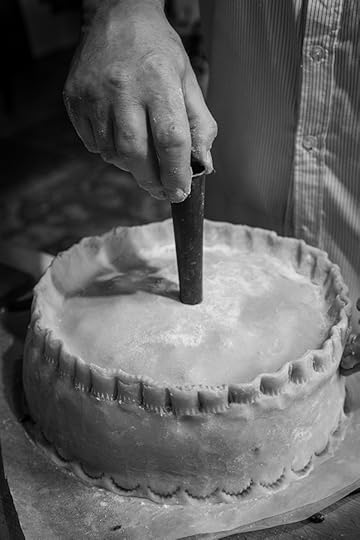
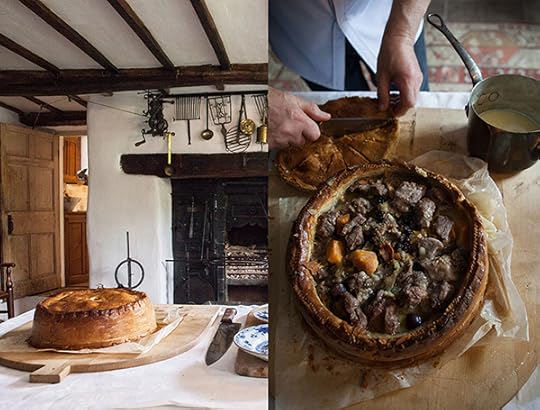
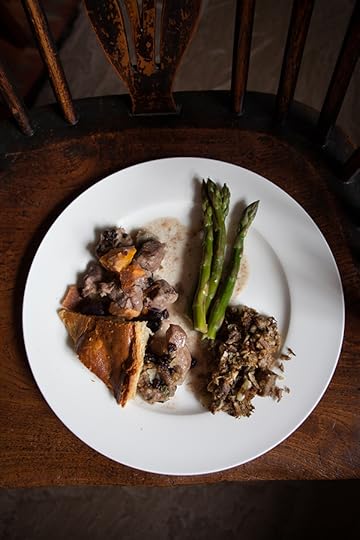
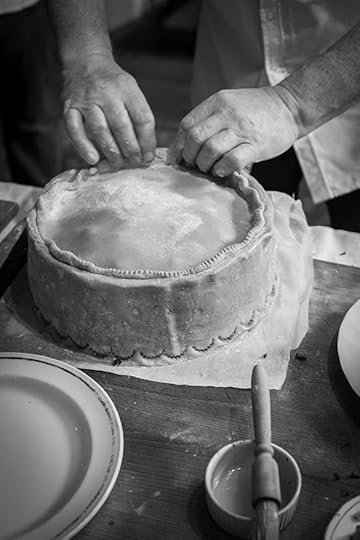
Published on May 19, 2015 16:18
May 14, 2015
Food Revolution Day - Food education back on the menu
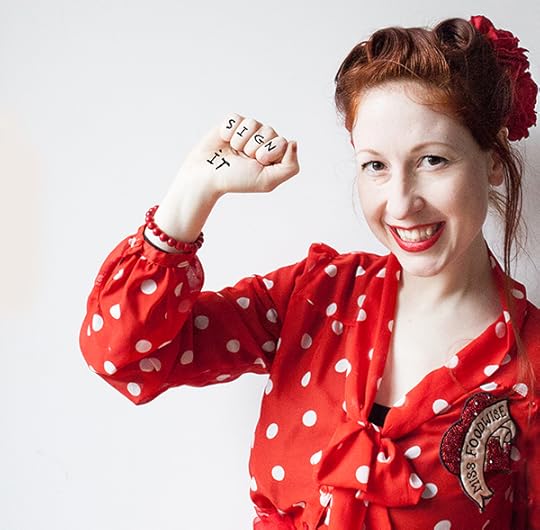 Sign the petition www.change.org/jamieoliver
Sign the petition www.change.org/jamieoliverToday is Food Revolution Day, the day on which we come together from all over the world to pull on the same end of the rope. A better future for our children is what is aimed at here, and better food education will bring that.
At a time when 42 million children under the age of five alone are overweight, we need to take action against this enormous epidemic.
In the olden days when the girls were supposed to marry to spend their lives cooking and cleaning for their husbands, girls were taught their skills in school and from their mothers. Today luckily us ladies aren't chained to the stove and washing basket anymore, but with our emancipation, slowly domestic housekeeping lessons disappeared from the schools.
So many people don't know how to cook from scratch because they weren't taught the basic skills to make a meal. It is of vital importance that cooking skills, and even growing food is put back on the schools learning plans. With a growing world population, we need to reduce food waste, and to do this, we need to cook more and learn how to deal with leftovers. It might seem so straight forward to you, whipping up an easy dinner after work, but for so many people out there it is a daily struggle. Those trying to survive on a tight budget have it even worse when they don't know how to cook.
I can always make a meal, it might be a strange dish sometimes, but it is always tasty. You tend to take that skill for granted. I know I did, it is only when you talk to someone who really can't cook that you understand that cooking is often a talent you're born with but others need to learn it. I learned from Jamie's Naked Chef Series because my mum wasn't really the type to teach you how to cook, she had a tendency to overcook things, or downright burn them to their second death.
My husband can't cook either. When we were 'courting' he made me a pasta dish with grated carrots which he had heated up in yoghurt. Not the luscious thick strained Greek style yoghurt, natural sour pungent yoghurt. It was one of the most vile things I've ever had to swallow. He thought so too and luckily I didn't have to finish the plate to be polite but how the hell could he have cooked that? Well, he followed a recipe. He doesn't use it intuitive nature because he doesn't know what he is doing. If he would have cooked from his heart, he would have made an entirely different dish. Like his eggs, he can cook a mean egg.
So teaching children to cook, teaching them about how food production - farming - works and maybe even re-introducing school gardens, might just save out future generations.
The fact that so many children don't know their onions from their tomatoes is downright shameful and unnatural. We are not surprised that children don't want to eat the pink slime they call meat in processed food when they see it in their raw state, but as soon as it is turned into chicken dips by Jamie in his School dinners show, the kids all go crazy for it, even knowing that minutes before it was just pink slime...
Education, education, education. It is the answer to everything.
So if you have a minute sign the petition to put food education back 'on the menu' in schools, and do it here www.change.org/jamieoliver
“By educating children about food in a practical, fun and engaging way, we can provide them with the knowledge and skills they so urgently need to lead healthier, happier lives. We need to make practical food education a compulsory part of every school curriculum across the world, and that’s why I’ve launched a petition calling on all G20 countries to action this. With enough support from millions of people around the world, I truly believe that we can create a movement that’s powerful enough to make governments take action.” Jamie Oliver
Sadly I didn't host my Food Revolution Event this year, life just was a little too hectic at the moment and I am seriously gutted about it but I can't make myself ill while trying. I'm in the final stages of photographing my book and testing recipes again, and I'm a one lady team here so I'm up to my ears in work. It's great, I'm super happy, but to organise an event this year, I couldn't do it alone, I would have needed a couple of people to help while I remain indoors like a hermit only going out when I need eggs and cream. :)
Next year will be double cool I promise, and if you like to volunteer to give a hand, always welcome, just drop me a line or a tweet or shout at me in the street! :)
Take care for now, and think about your food consumption today, learn someone something about food, think of where your meat comes from, your fish, your poultry, your eggs, ... Think about it, share your thoughts, get conversations going.
x
Regula
Enjoy some pictures of my past Food Revolution Events!
"The future for me starts with food education"
Jamie Oliver
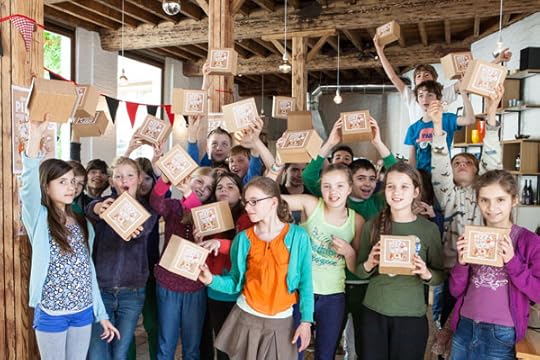 Making pizza in a woodfired oven
Making pizza in a woodfired oven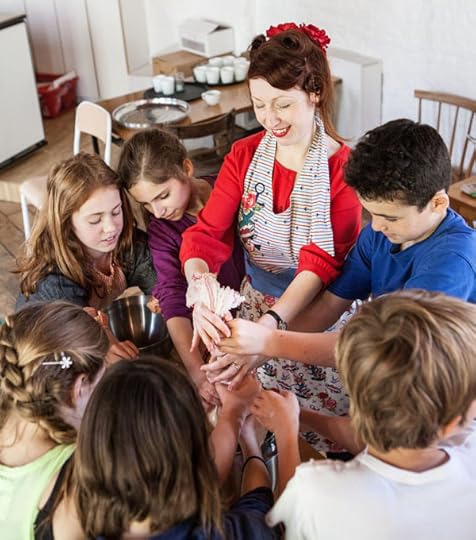 Squeezing the whey out of the cheese
Squeezing the whey out of the cheese
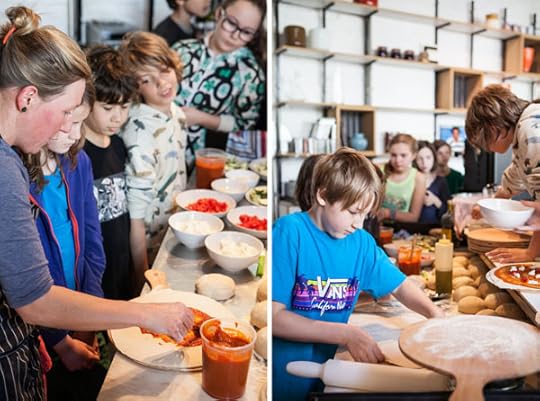 creative with toppings
creative with toppings
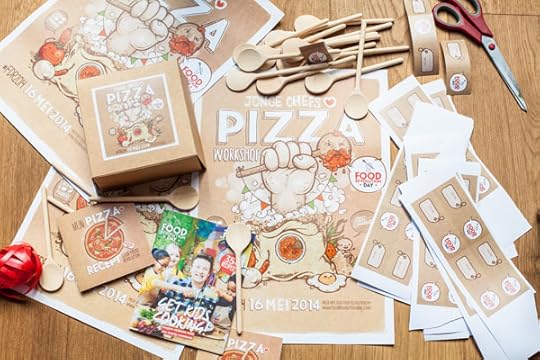
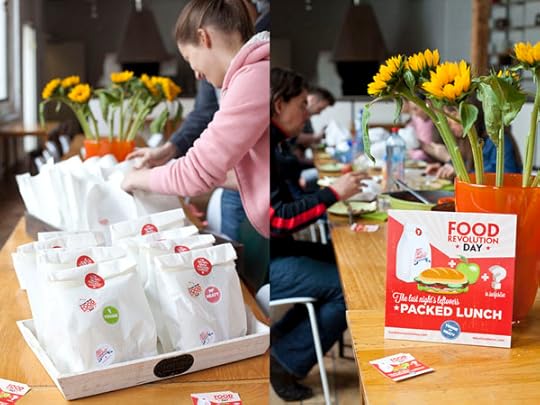
You might also enjoy:
Mussels and fries for Food Revolution Day >
Published on May 14, 2015 14:44
April 10, 2015
Smithfield Meat Market - a history and a nomination for the Pink Lady Food photography award!
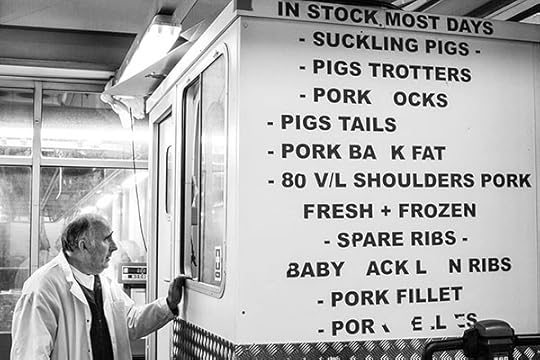 Dear readers, the above image from Smithfield market has been shortlisted in the prestigious Pink Lady Food Photography Awards in the category 'Food For Sale' for the People's choice award. If you like my work, I would be super grateful if you would vote for my photograph!
You can vote HERE > and scroll down to 'Food for sale'
Thanks so much xx
Dear readers, the above image from Smithfield market has been shortlisted in the prestigious Pink Lady Food Photography Awards in the category 'Food For Sale' for the People's choice award. If you like my work, I would be super grateful if you would vote for my photograph!
You can vote HERE > and scroll down to 'Food for sale'
Thanks so much xx
Smithfield Market, 865 years of notorious history of meat, bloodshed, crime and uprising.
Turning down Sun Street and Crown Street, and crossing Finsbury square, Mr. Sikes struck, by way of Chiswell Street, into Barbican: thence into Long Lane, and so into Smithfield; from which latter place arose a tumult of discordant sounds that filled Oliver Twist with amazement. It was market-morning. The ground was covered, nearly ankle-deep, with filth and mire; a thick steam, perpetually rising from the reeking bodies of the cattle, and mingling with the fog, which seemd to rest upon the chimney-tops, hung heavily above. All the pens in the centre of the large area, and as many temporary pens as could be crowded into the vacant space, were filled with sheep; tied up to posts by the gutter side were long lines of beasts and oxen, three or four deep. Countrymen, butchers, drovers, hawkers, boys, thieves, idlers, and vagabonds of every low grade, were mingled together in a mass; the whistling of drovers, the barking dogs, the bellowing and plunging of the oxen, the bleating of sheep, the grunting and squeaking of pigs, the cries of hawkers, the shouts, oaths, and quarrelling on all sides; the ringing of bells and roar of voices, that issued from every public-house; the crowding, pushing, driving, beating, whooping and yelling; the hideous and discordant dim that resounded from every corner of the market; and the unwashed, unshaven, squalid, and dirty figues constantly running to and fro, and bursting in and out of the throng; rendered it a stunning and bewildering scene, which quite confounded the senses.
Charles Dickens - Oliver Twist, 1838
And so were the words of Charles Dickens about Smithfield meat market in his marvellous work Oliver Twist.
England has always been famed for the outstanding quality of its meat. In the 19th century, Smithfield meat market was notorious for its wild cattle that was hazardously driven through the streets of London. The drovers and butchers were apparently as savage as their cattle and murder and rape were no exceptions in these quarters.
Reports of cattle stirred up by drunk herdsmen killing men, woman and children on their way were frequent. Cattle was slaughtered at the site and the streets coloured red with blood.
Surrounded by dirty streets, lanes, courts, and alleys, the haunts of poverty and crime, Smithfield is infested not only with fierce and savage cattle, but also with the still fiercer and more savage tribes of drivers and butchers. On market-days the passengers are in danger of being run over, trampled down, or tossed up by the drivers or “beasts”; at night, rapine and murder prowl in the lanes and alleys in the vicinity; and the police have more trouble with this part of the town than with the whole of Brompton, Kensington, and Bayswater. The crowding of cattle in the centre of the town is an inexhaustible source of accidents.Max Schlesinger, Saunterings in and about London, 1853
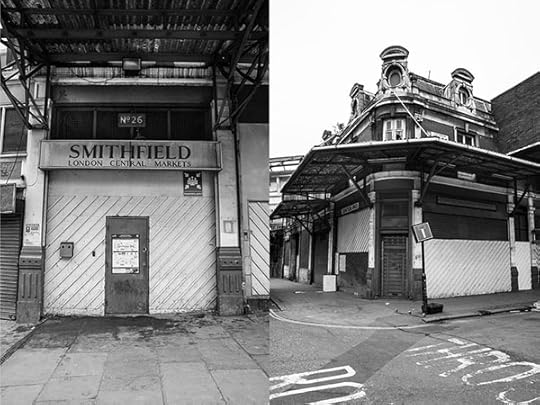
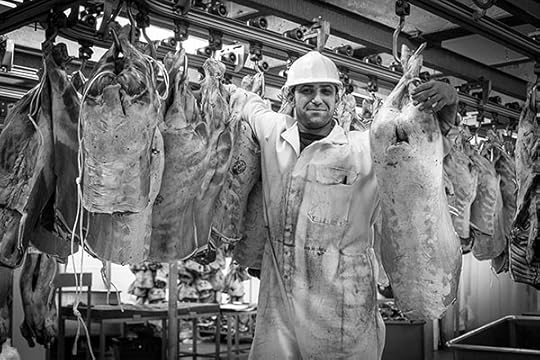
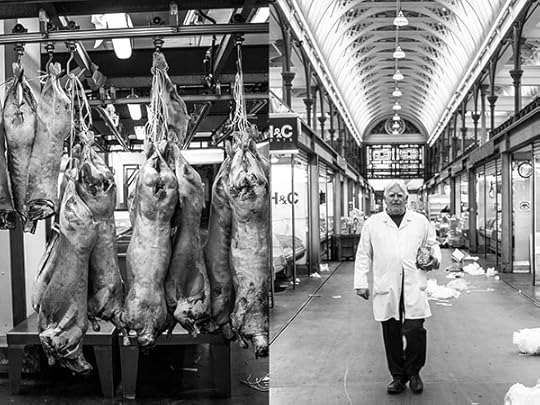 From 1150,
From 1150, Smithfield has been used as a market for live stock. It was a large open space on the outskirts of town, it had small open spaces and wooden pens and a broad open street market.
In 1174 Smithfield was described by William Fitzstephen, clerk to Thomas à Becket in his 'Description of London', one of my favourite works to learn about Ancient London and its people.
'In a suburb immediately outside one of the gates there is a field that is smooth, both in name and in fact. Every Friday (unless it is an important holy day requiring solemnity) crowds are drawn to the show and sale of fine horses. This attracts the earls, barons and knights who are then in the city, along with many citizens, whether to buy or just to watch.'
A description of London, ca.1174/1183, translated from Latin.

The ancient map of London 'Civitas Londinum' dated to 1561, shows large open fields and cattle pens. The market area is now called 'Schmyt Fyeld'. During that time the market area had access to the river Fleet so cattle had water to drink and grass to feed on.
Because Smithfield was an open space which was so close to the city centre, it was also used for public executions. William Wallace - known to most as Braveheart after the film - was executed there in 1305. It was also the meeting place to gather for the Peasant's Revolt in 1381. Executions continued well into the 16th century with Henry VIII murdering Catholics and his daughter 'Bloody Mary' burning in excess of 200 protestants. During the 17th century the site became a popular place for duelling and later it turned into a prime spot to pick up a prostitute for the night.
The structure of the market would remain largely the same as in the Middle Ages until a building was erected designed by Victorian architect Sir Horace Jones in 1868. By then the market was in the centre of London instead of in the outskirts, adjoining fields.
We can still see that majestic market building today, and some of its additions from later in that century, but sadly a part of it has been derelict for many decades now.
When I visited the market I was warned by Londoners that some of the butchers were still cheeky buggers and they weren't kidding. On my short walk around I got talking to one of them, I took his picture, asked him if I could use the image, and he gave me his phone number and told me to call him some time.
The market was at its end of trading that day when I visited, meat was being packed up and carted away in supermarket trolleys, leaving it to look nearly as rough and dirty as it must have looked centuries ago.
It is a historic place, there has been a cattle market here for 865 years, and I hope it will remain here for centuries to come. It's extraordinary that after the relocation of Billingsgate Fish market, Covent Garden and Spitalfields market, Smithfield market is still holding strong.
It is a heritage site, and with so many historical important places being demolished in London today - think the London Wool and fruit exchange in Shoreditch - we have to hang on to this one while we can.
 Looking up in the meat market building
Looking up in the meat market building
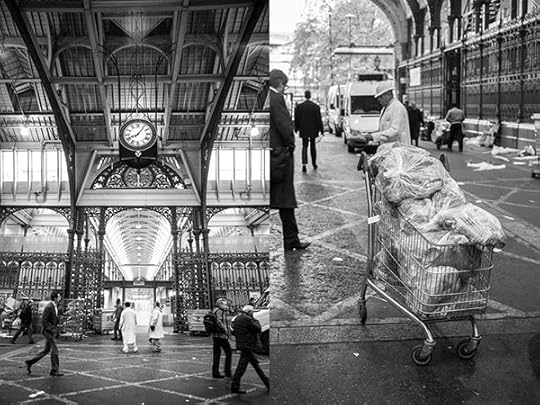 Supermarket carts are used to move the meat and are scattered around everywhere
Supermarket carts are used to move the meat and are scattered around everywhere
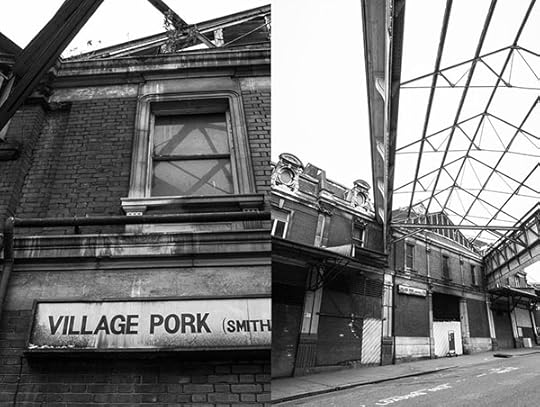 though crumbling, still a special place
though crumbling, still a special place
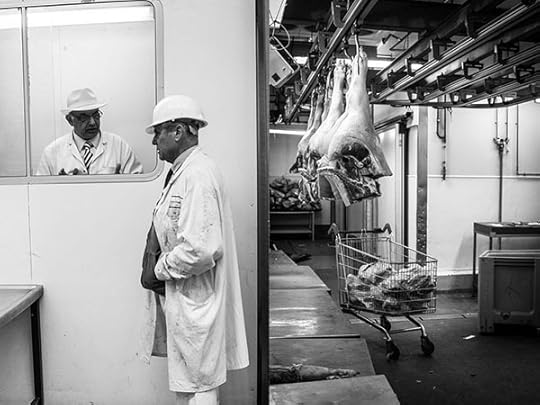 Butchers chatting during the clean-up of todays market day
Butchers chatting during the clean-up of todays market day
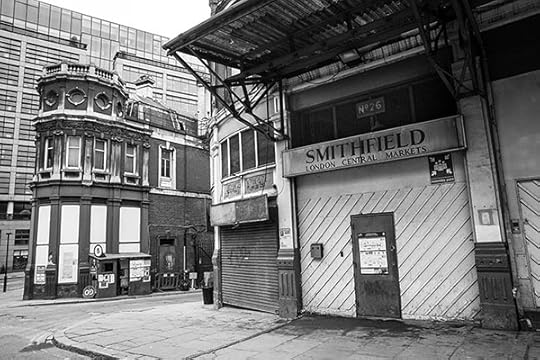 One of the loading gates
One of the loading gates
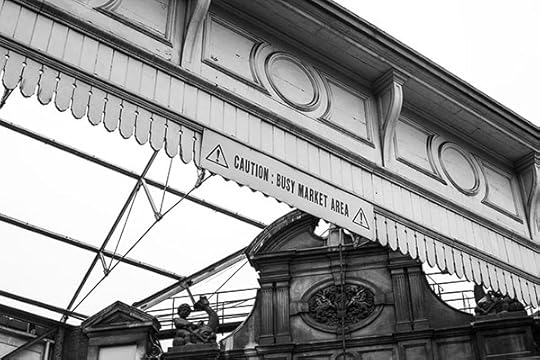 Lorries are driving on and off with loads of meat
Lorries are driving on and off with loads of meat
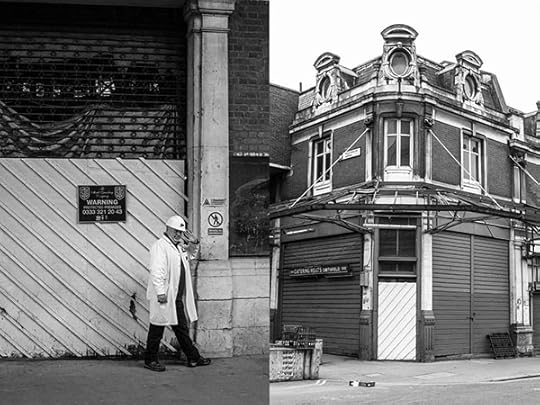 The butchers don't mind posing a little for my camera
The butchers don't mind posing a little for my camera
 Part of the market in its derelict state, still waiting to be renovated and repurposed
Part of the market in its derelict state, still waiting to be renovated and repurposedDo leave a comment, I love hearing from you!
Published on April 10, 2015 03:21
April 5, 2015
The Irish Midlands
 Leap Castle, Ireland's most haunted castleLast week Bruno and I were invited by Mid-Ireland tourism to come over for a weekend to explore what the Irish Midlands has to offer. It was going to be our first visit to Ireland and we were looking forward to it for a month. We both had one of the busiest times since a very long time, for me it was finishing the English manuscript of my book, for him it were hundred and one things.
Leap Castle, Ireland's most haunted castleLast week Bruno and I were invited by Mid-Ireland tourism to come over for a weekend to explore what the Irish Midlands has to offer. It was going to be our first visit to Ireland and we were looking forward to it for a month. We both had one of the busiest times since a very long time, for me it was finishing the English manuscript of my book, for him it were hundred and one things.It was a relief to step on that airplane - though with the disaster of the German plane crash from a week earlier in the back of our heads - knowing that we were able to take these four days away from our work. We came back revived and full of creative energy. Let me share our highlights with you.
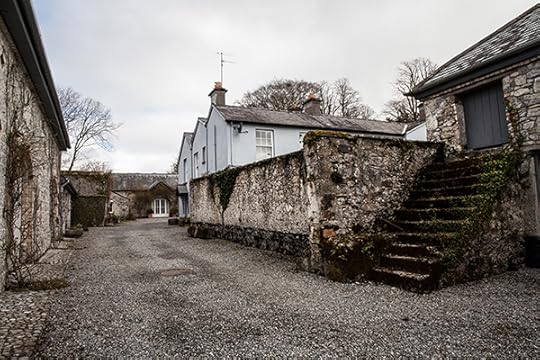 Bellefield Gardens
Bellefield GardensThe first day of our trip we visited the Birr Theatre where regular plays are offered but also workshops for kids, when we were there to assemble for tea, kids were learning to do stop-motion films. So great to get the kids to do creative things.
Home away from home
We then drove off to go and see the beautiful gardens by Garden designer Angela Jupe at Bellefield Gardens . Angela is a garden designer after my own heart. The gardens look very rustic and not at all staged. She works with salvaged materials and creates new things with it. She restored the farmhouse and all the cottages surrounding its courtyard. You can hire them, they each have a cosy log burner, a kitchen and a private little garden. A real treat if you want to get away from the rat race and spend some time walking around the beautiful surroundings and cooking up amazing food to enjoy by the fireplace. I wish I had just 1% of Angela Jupe's gardening talent. The whole estate is truly enchanting.
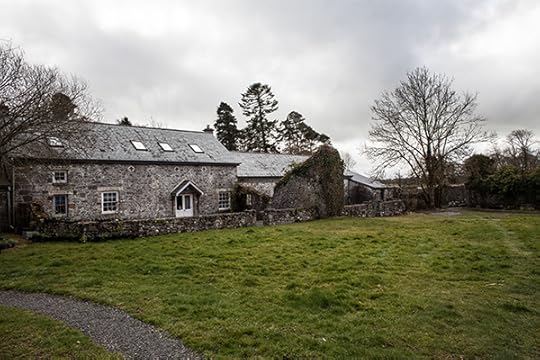
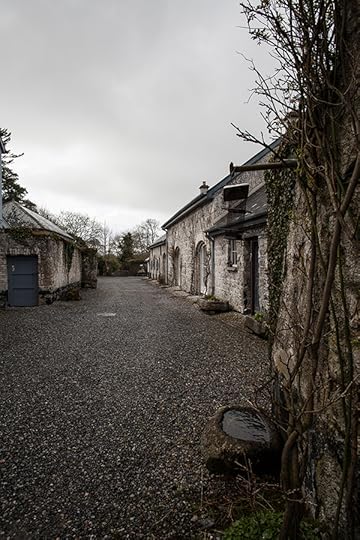
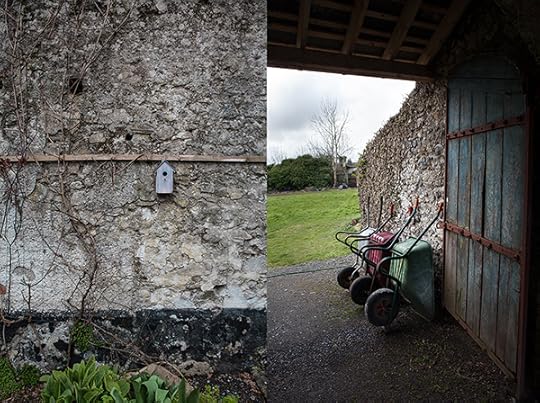
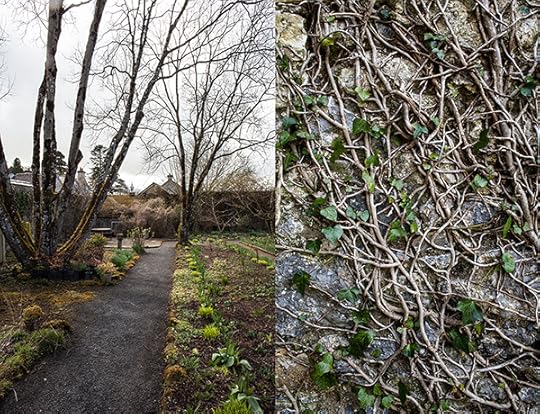
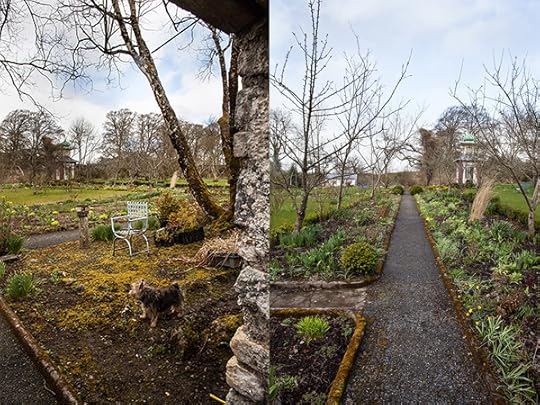
Fairytale garden
Back in the buss we went to see Fancroft Mill just over the border in Tipperary. The owners bought this derelict mill, garden and millhouse from Angela Jupe who had designed the garden and then sold it because the derelict mill was an enormous project to take on. The new owners restored the watermill, which is housed in a very tall building than can be seen from a distance in the rolling countryside. They accidentally became millers with it. The gardens are - like Bellefield Gardens - immaculately rustic and the little tower makes it look like a fairytale setting. I could sit in this garden for hours, and in fact the owners tell me that that is what they tell visitors, to take their time exploring and sitting in the garden.
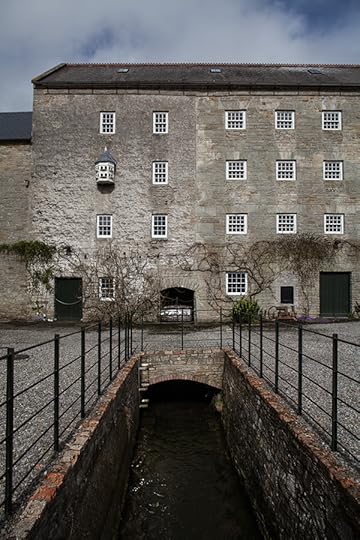
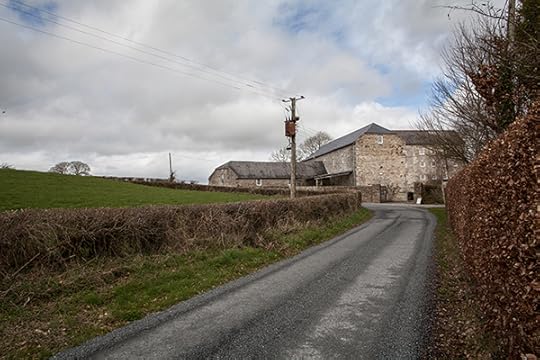
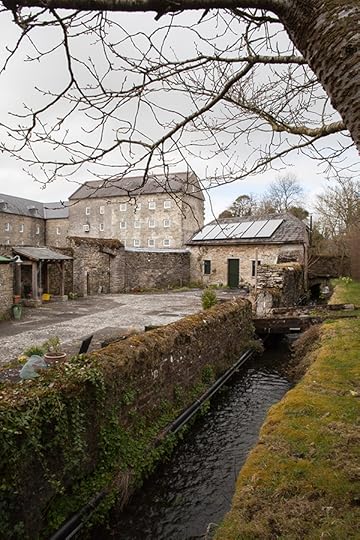
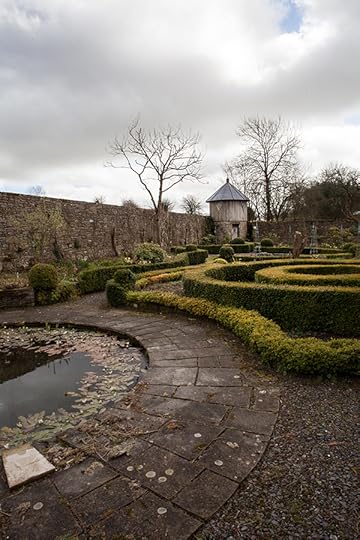
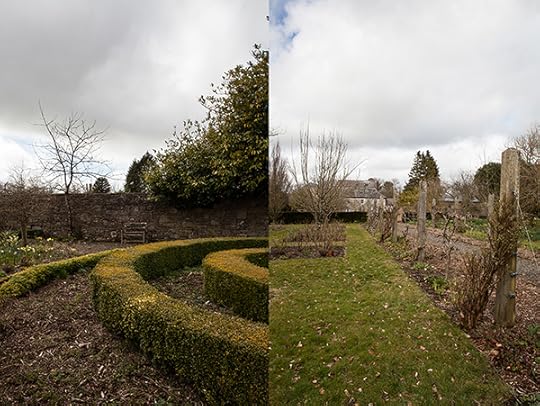
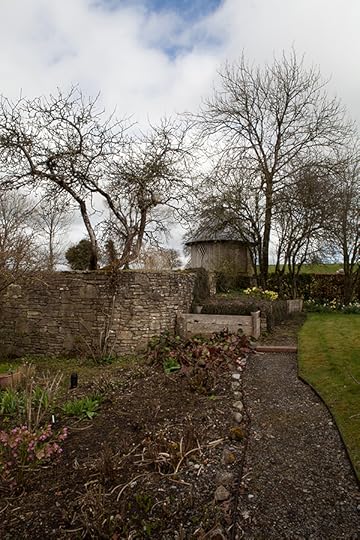
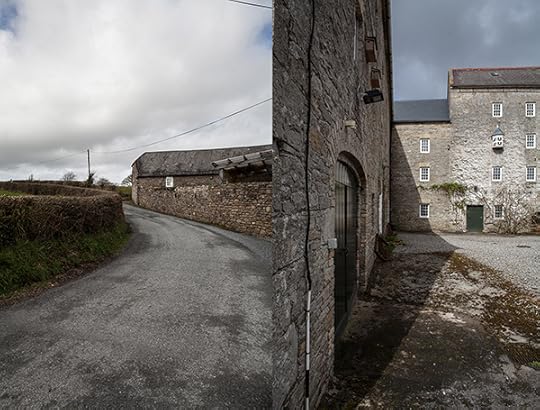
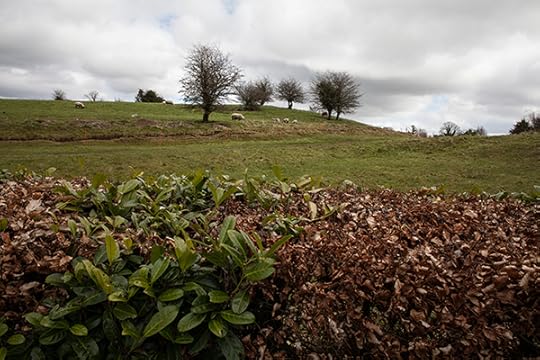 Haunted as hell
Haunted as hellThe next stop is Ireland's most haunted castle - a real treat for Bruno who is a fan of horror movies and other gothic things. Leap Castle is a ruin, but it is lived in by Sean Ryan and his family. It must have looked imposing in its heyday, and scary too because if you committed a crime on these lands, which could have been poaching a rabbit, you were read your last prayer on the top floor of the castle where the 'Bloody chapel' is - or was - and then thrown into a hole which was lined with spikes on the bottom - yikes.
The castle was built in the 1500's and originally named 'Leim Ui Bhanain' meaning ’Leap of the O’Bannons’. The O’Carrolls, the clan who owned the castle, were a fierce and brutal people. They were known for their cruel tactics, killing those that came on their path. The 'Bloody chapel' has an 'oubliette', a narrow room, more like a hole where people where in the 1930's three cartloads of human bones were removed. The grandfather of our bus driver was one of the workmen on the job. Sean, the owner of the castle told us about the spirits in his home but ensures us they are not evil, but that they are there. Constant murdering had been going on in the castle up until the 18th century. And at one time one of the owners was so involved with the occult that she summoned a dark spirit that thankfully has remained quiet but is still in the castle. Leap castle was looted and burnt by IRA militants in 1922 during an uprising when it was owned by English aristocracy. Stories say that the villagers from the surroundings stood there laughing when the castle went up in flames. But they did spare the life of the caretaker and his wife and child. The English family who owned was not present when the castle got reduced to the ruin it is today. Did I see a ghost? No, but I can't help but wander what I felt as you go into the cold castle knowing it is haunted, and aware of all the monstrous murders that have happened there.
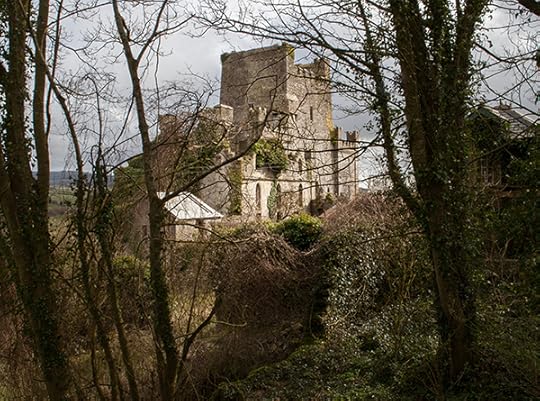
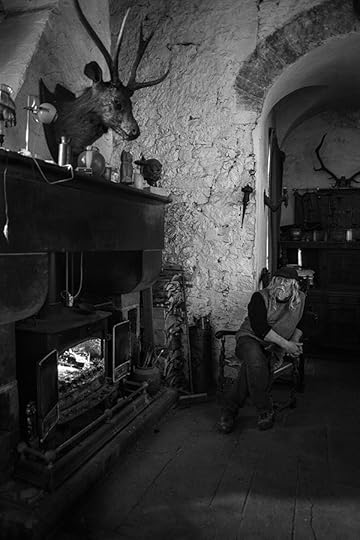
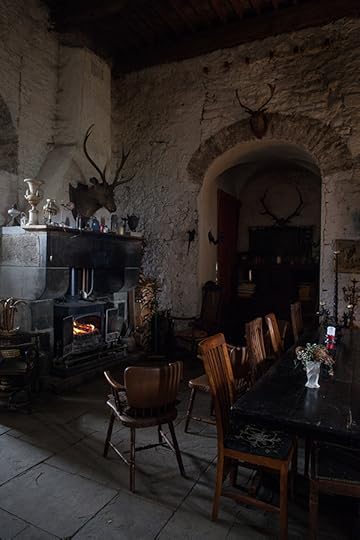
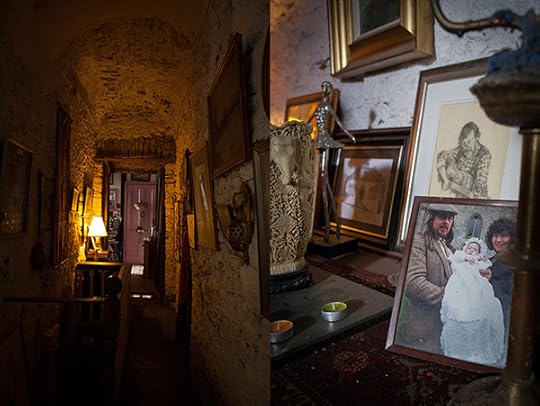
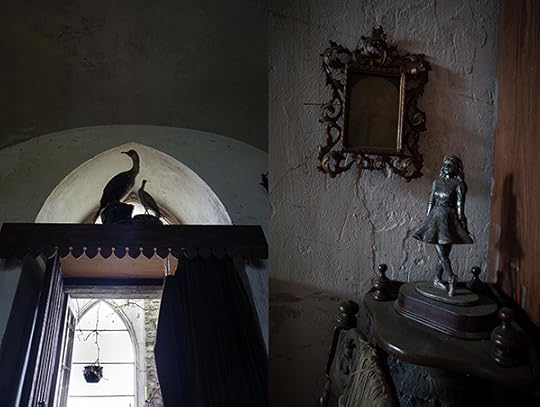
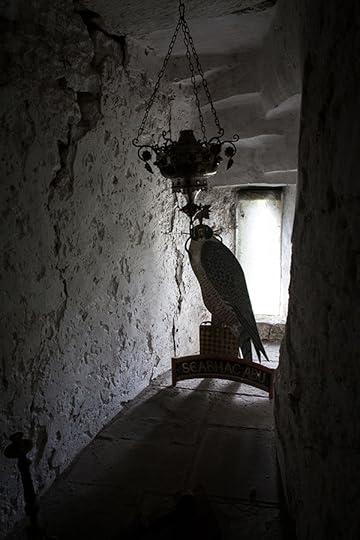
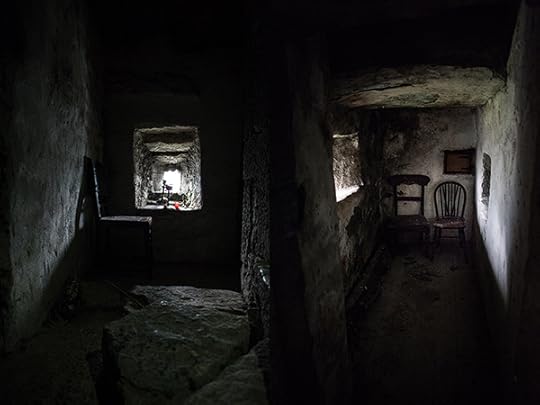
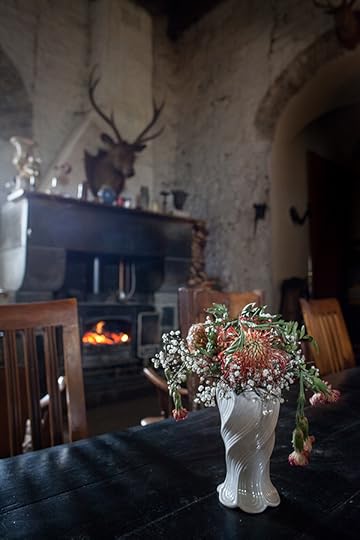

 Lough Boora Parkland was next on our trip but required more time than we had. This is a location to spend a day or an afternoon walking, riding bikes and eating cake at the end of the day. Its surroundings are impressive with ancient bog- and wetland. There is also a nice collection of fauna and flora to admire as well as artwork which is placed in the park without disturbing it.
Lough Boora Parkland was next on our trip but required more time than we had. This is a location to spend a day or an afternoon walking, riding bikes and eating cake at the end of the day. Its surroundings are impressive with ancient bog- and wetland. There is also a nice collection of fauna and flora to admire as well as artwork which is placed in the park without disturbing it.
Birr Castle was the end to our first day and is an impressive castle and estate, it houses a Science museum, Telescope and some fun for the kids too. Mind you I would have gone on the jumping air bed if it wasn't for the rain! For those who are as geeky as I, the grounds of the estate also have an ice house. But you have to ask where it is. We were treated to a tour of the castle itself which is still a private home. It was a privilege to be shown around there and to see an actual living home rather than a museum. The castle has a couple of secret passageways which we explored and I could already imagine the fun you could have as a child growing up in such a place. Allow at least half a day here as there is lots to be seen.
 Birr Castle, sadly no pictures from the inside as it is a private home.
Birr Castle, sadly no pictures from the inside as it is a private home.
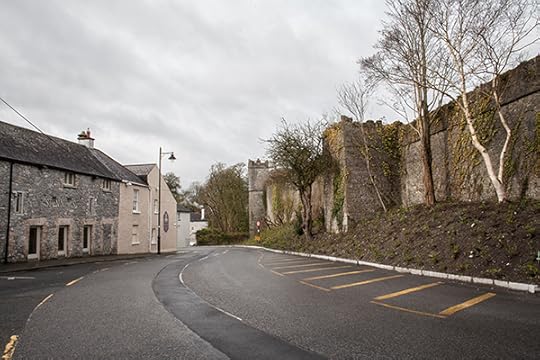 Spinners hotel and restaurant - right opposite Birr Castle
Spinners hotel and restaurant - right opposite Birr CastleThe next day were invited for tea, scones and cakes at Memory Antiques who were very excited to show us all their auction room and bits and bobs. It is conveniently located opposite the entrance of Birr Castle and just round the corner of our hotel. Full with tea and divine lemon syrup cake, off we went for a little cruise on the river Shannon with Silver line cruisers. When we arrived Dublin we carpooled in our taxi with a German family on their way to hire a boat there for two weeks. Apparently the river Shannon is full of fish and therefore people love to boat around and fish for their supper. The surroundings of the river Shannon were tranquil with some rough landscape. Nice to see only nature and an occasional house or ruined barn.
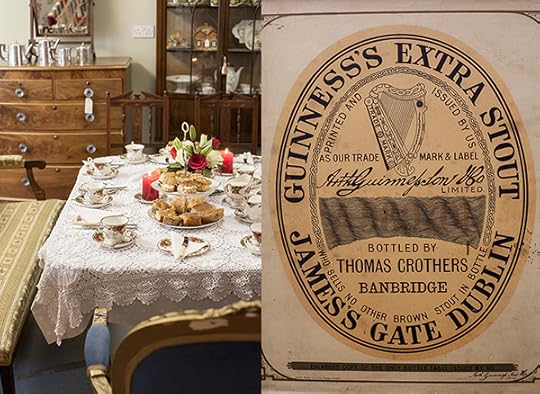 Tea and cakes for us at Memory Antiques. Lots of Guinness stuff, sadly sold!
Tea and cakes for us at Memory Antiques. Lots of Guinness stuff, sadly sold!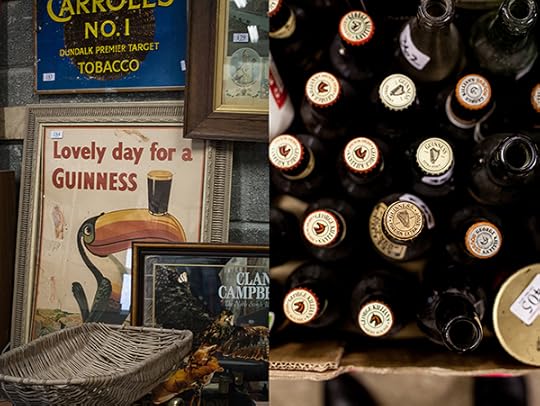 Sadly they were sold, I'd been looking out for a vintage Guinness poster, especially the one with the bird!
Sadly they were sold, I'd been looking out for a vintage Guinness poster, especially the one with the bird!
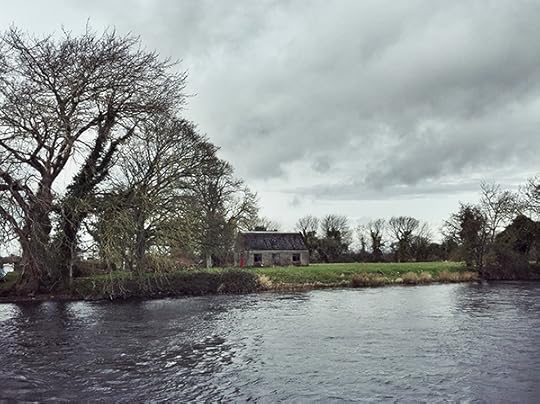 Silver line cruise on the river Shannon
Silver line cruise on the river Shannon
 Alfie from Mid Ireland Tourism - also pig farmer at Olde Farm
Alfie from Mid Ireland Tourism - also pig farmer at Olde FarmWe only had two days in the Midlands but you could spread this to a week and thoroughly explore. I would go back for a walk around Leap Castle, and another visit to the castle itself. I would also like to stay at Bellefield Gardens to cook with the local produce and enjoy the little garden that comes with each little cottage. Birr castle is a day trip, rounded off with a visit to memory antiques and a dinner at Spinners. And Lough Boora parkland is definitely the place for a day of walking. It was a real treat to get a taster of Irish culture, which is similar to the English but oh so very different as well. I definitely want to explore more of Ireland! Thank you Alfie from Mid Ireland Tourism and Margaret from Olde Farm, this husband and wife team, who I have known for a couple of years now, have done a fabulous job organising this trip. Thank you so much! x
Food and lodgings
Spinners on Castle Street, Birr
We flew to Dublin and from there it was about one hour and forty-five minutes to drive to Birr, a small town in the Midlands. Margaret, the fire behind this trip had booked us into Spinners in Birr, a beautiful old stone building opposite Birr Castle. Spinners is a place with a big potential to become a foodie destination in the Midlands. Its location is central, its surroundings are beautiful, the food is the best we have tasted in the Midlands and Birr is apparently one of the favourite towns in the area.
Jordan who owns Spinners is very passionate about his business and I hope his hotel and restaurant will thrive. The Irish breakfast was fantastic, with tasty bacon and one of the best bangers I've ever tasted. The next day he had gone out for the best local black pudding, and I have to agree, it was very good indeed. We had dinner there on the first evening of our stay and the place was packed, so it was on the next day. It looks like Spinners is no longer a secret!
Olde Farm
Margaret and Alfie have an Air Bnb room in their lovely pig farm just outside Birr. If you prefer to stay at a B&B this is your thing. You will get a brekkie cooked with home reared produce and a nice chat. Margaret and Alfie know heaps about these surroundings so can point you to the best places to go.
Bellefield Gardens , the home of Angela Jupe. "In 1987 she established and ran the first specialist garden shop in Ireland – "The Garden Furnishing Co." and set up the Traditional Gardening Co. which specialised in garden design and construction."
She now lives at Bellefield Gardens, where she lovingly looks after her garden and holiday cottages. She is passionate about Irish snowdrops and has a wide variety of them in her grounds.
Mossfield Organic farm cheese
The organic shop, Mainstreet, Birr
This shop sells Mossfield organic farm cheese, truly wonderful cheeses from the Slieve Bloom Mountains.
Killeen farmhouse cheese
A very creamy parmesan style hard goats cheese, available in some shops
Bo Bristle brewery
Absolutely loved the IPA, a very easy drinker and lovely with food
To see and do in the Midlands
Gardens - Houses
Bellefield Gardens
Gardens designed by Angela Jupe, hope of the Irish snowdrops
Leap Castle, north of Roscrea on the R421
Open to visitors but you have to contact the owner Sean Ryan first. Entry fee goes to restoring the castle
Birr Castle, Birr, Castle street
An impressive castle and estate, a Science museum, Telescope and some fun for the kids too. For those who are as geeky as I, the grounds of the estate also have an ice house. But you have to ask where it is.
Fancroft Mill
Gardens designed by Angela Jupe and an impressive water mill.
Tea and cakes can be enjoyed in the café
Walking - Biking - boating
Lough Boora Parkland
An ancient Bog land with tranquil nature to walk or ride a bike in. A café is there for necessary cups of tea and cake after outdoor exercise
Silver Line Cruisers
Boat hire on the River Shannon, you can get off and pick-nick in the beautiful countryside.
Culture
Birr Theatre
for plays, exhibitions and workshops
Antiques
Memory Lane
antiques and auctions, opposite the entrance of Birr Castle, Birr
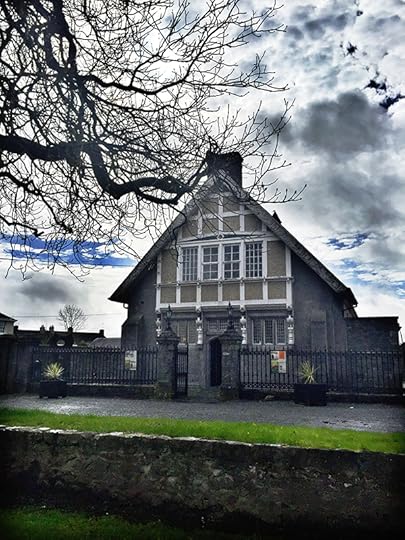 Birr Theatre - moody skies
Birr Theatre - moody skiesI was invited by my Mid Ireland Tourism, my views are my own. I was not payed to write a review, I blog whatever I want so you know that when you read something here, it is always coming from me and me alone.
Published on April 05, 2015 08:28



